Most visitors rave about the food of Greece. In this article, you will find some of the most popular Greek dishes, and some that you may not have heard of. I’ve also included a few desserts. This Greek food guide will be useful to first-timers but also to seasoned visitors 😊
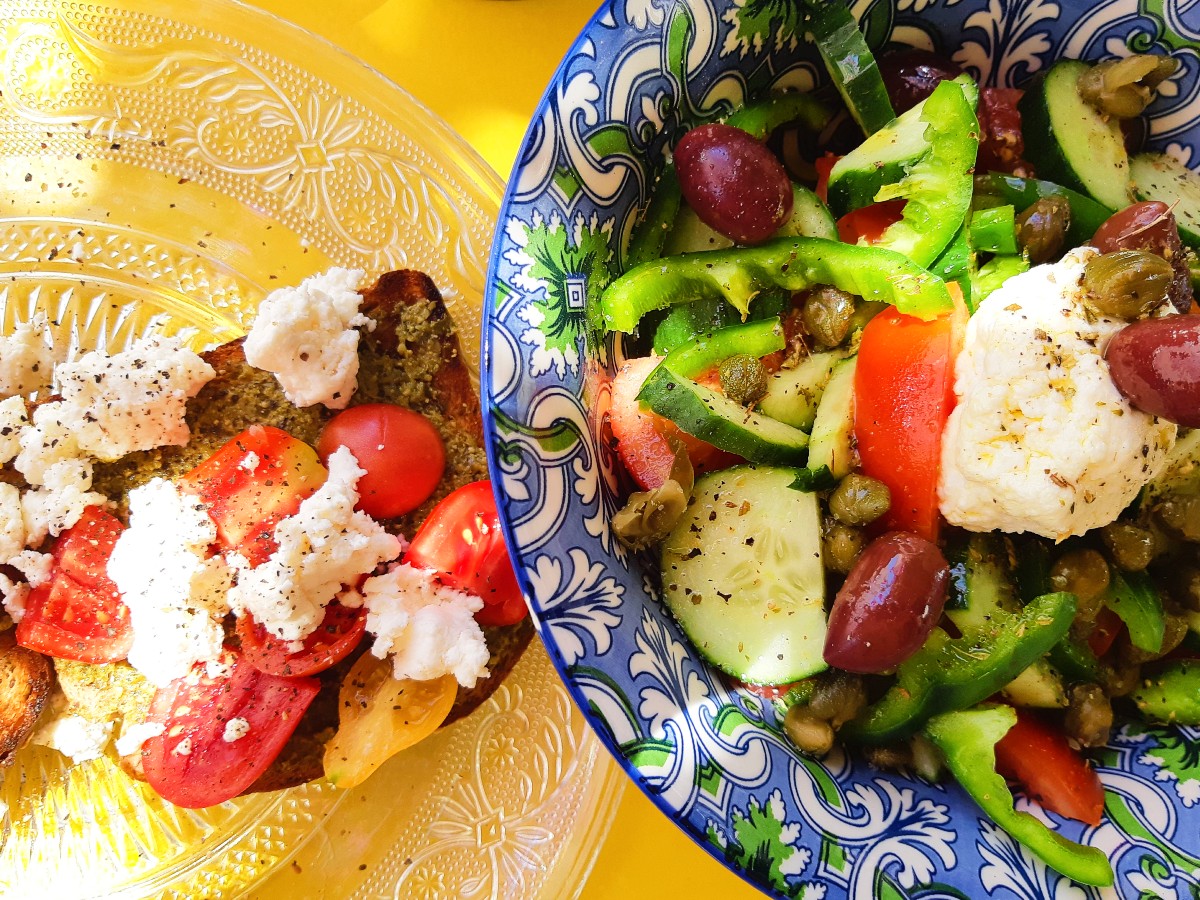
What is the food of Greece like?
Before I jump into this long list of Greek foods, let me say one thing: I’m Greek. So, I know a thing or two about real Greek food! Plus, I was spoiled – my mom and both grandmas were exceptional cooks.
Greek cuisine is quite varied. The main ingredients are fresh vegetables, pulses, meat, fish, seafood, eggs and several types of cheese. Olive oil, onions, herbs and spices feature in most traditional dishes.
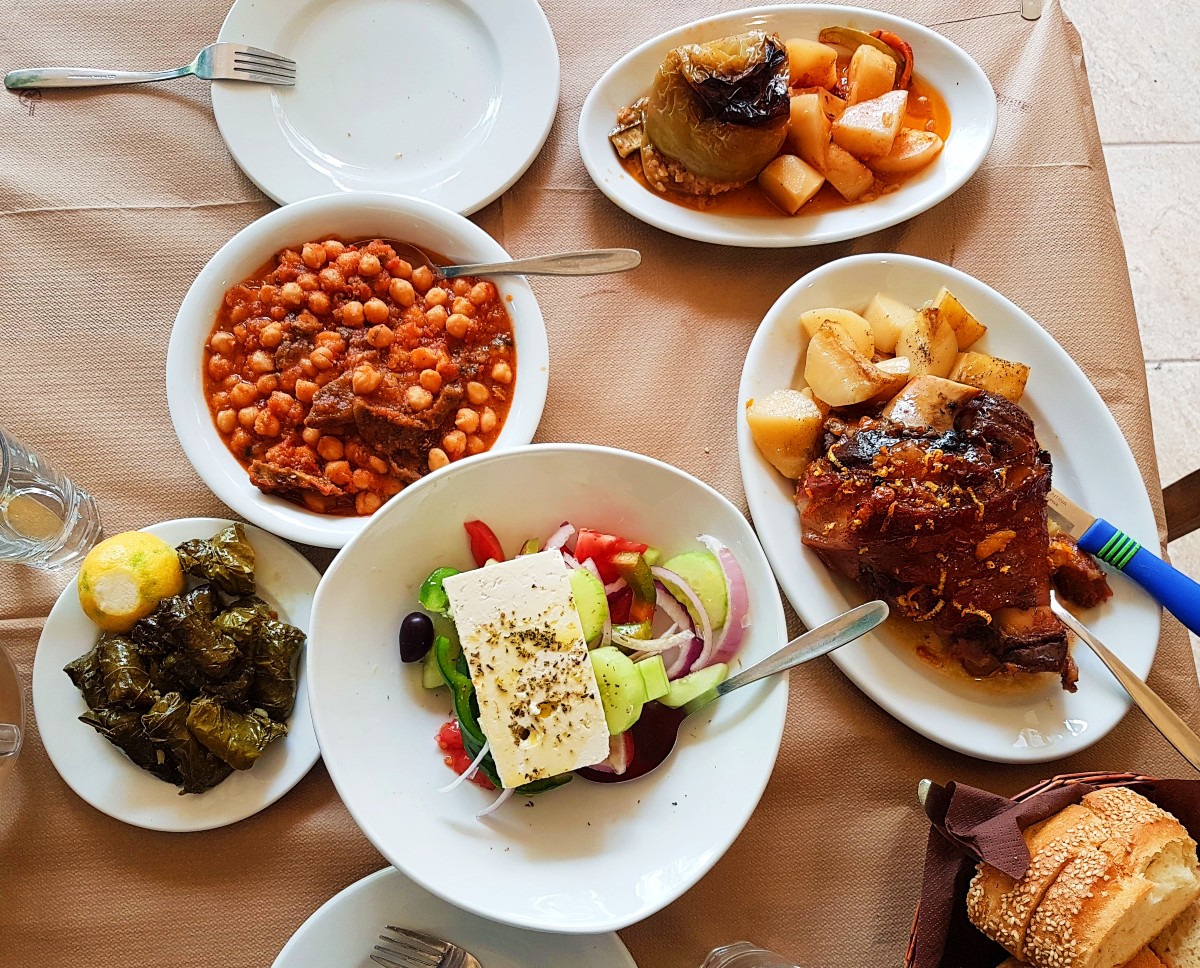
One thing that I find quite special about Greek food is that there isn’t always a clear distinction between starters and mains. In fact, sharing food (and alcohol) is a huge part of the Greek culture.
In a way, the company and chat are more important than food itself.
Regardless, I’ve included an indication of whether the dish is normally meant to be a starter or a main course. I’ve also highlighted Greek vegetarian and vegan dishes, though you should always double-check as some ingredients may vary.
So, here’s the best food of Greece, starting with some of our famous dishes!
Horiatiki – Greek Salad
– Salad (Vegetarian)
If you are reading this article, you are probably familiar with Greek salad. Some people would describe it as the national dish of Greece. It’s definitely one of the most popular foods in Greece!

Now, a Greek salad has very specific ingredients. It contains tomatoes, cucumbers, green peppers, onions, olives, feta cheese, salt, oregano and extra virgin olive oil. You may find regional variations around Greece.
One thing is certain – Horiatiki does not contain ham, eggs, avocado, yellow cheese or anchovies. These are all ingredients I’ve seen in Greek salads abroad! Yikes!
A Greek salad can be shared, but it’s often a main course for a light lunch or dinner. Fun fact – horiatiki best translates to “rustic”, or “peasant”.
Gyros Pita
– Street food
Gyros with pita is one of the best known foods of Greece. It consists of a thick pita bread, filled with pieces of meat, tomato, green salad, onions, our garlicky tzatziki dip and fries.
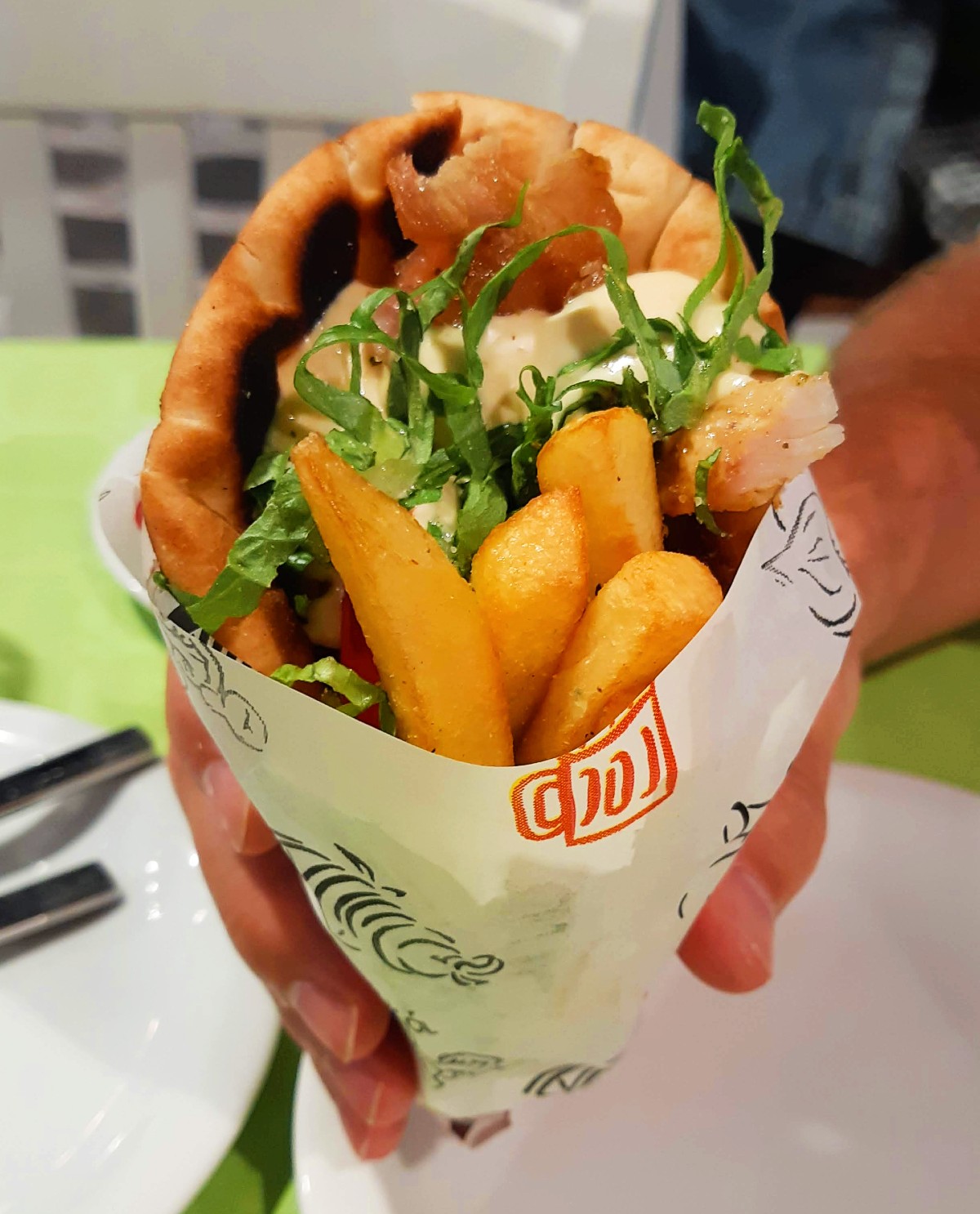
Contrary to popular belief, the gyros meat is usually pork or chicken, rather than lamb. The meat is grilled on a special grill that rotates in a circular motion, hence the name – gyros literally means “rotation”.
You can easily eat gyros pita on the go, though it can get a bit messy – you have been warned! If you are seated, the gyros meat will also be available on a platter, along with pita bread, french fries and a side salad.
Souvlaki
– Street food
I’ve seen people describe Greek souvlaki as Greek kebab, which is not really the case. Souvlaki consists of bite-sized pieces of meat, usually pork or chicken, that have been grilled on a stick.
The most common type of souvlaki comes in the form of small meat skewers, on wooden sticks. These can easily be eaten on the go, or at the table. Some people choose to put the souvlaki in a pita bread, like gyros.
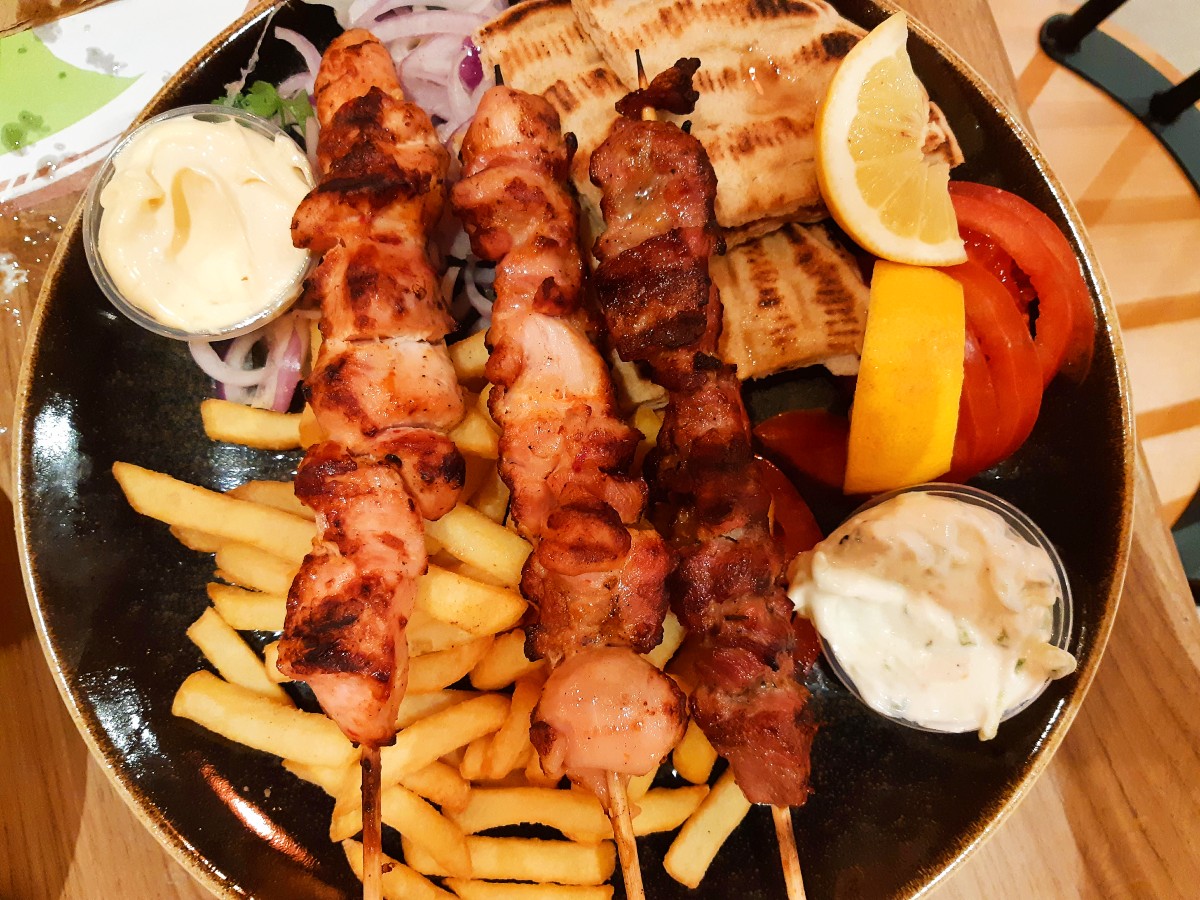
Bigger souvlakia are also available. These are larger pieces of meat, on a long metal stick, and people would order them as a main course. They are normally served with fries, a bit of salad, tzatziki sauce and pita bread.
Along with gyros, souvlaki is readily available anywhere in Greece, and most people visiting Greece have heard of it. It’s fair to say that souvlaki is one of Greece’s national dishes!
Moussaka
– Main
Moussaka is one of the most famous Greek dishes. It’s a rich oven dish containing fried eggplant and potato, minced meat cooked with tomato, onions and wine, and a thick bechamel sauce on top.
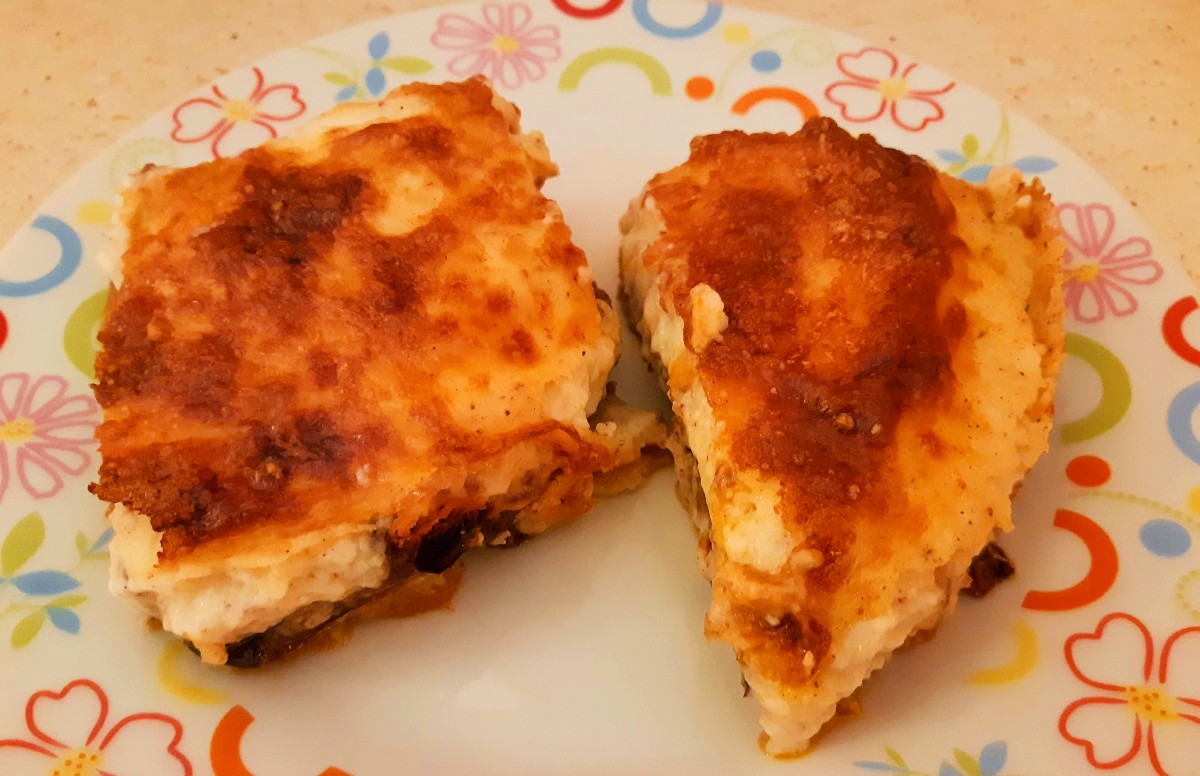
Making a good moussaka is quite time consuming. But, for people who like rich dishes, the result is absolutely worth it. I’ve only made it once – and decided I won’t make it again! Here is a great moussaka recipe from our renowned chef Akis Petretzikis.
Dolmadakia
– Starter (Usually vegan)
Dolmadakia, aka stuffed vine leaves, might be the most famous starter in Greece. They consist of vine leaves that have been stuffed with rice and herbs.

It’s a time-consuming dish to make, but so delicious! Some people like them with tzatziki, or with a yoghurt and dill sauce. Occasionally, you will find variations with minced meat.
Tip – You can get the best dolmadakia in Athens at Nikiforos taverna near Panormou metro station. I’m so lucky to have a neighbour who brings me some now and then!
Tiropita – Greek cheese pie
– Starter / Snack (Vegetarian)
Tiropita is the Greek word for cheese pie. You can buy this savory snack in all Greek bakeries, and it often features in restaurant menus. A tiropita can be served as a starter, but some people will find it filling enough to be a main course.
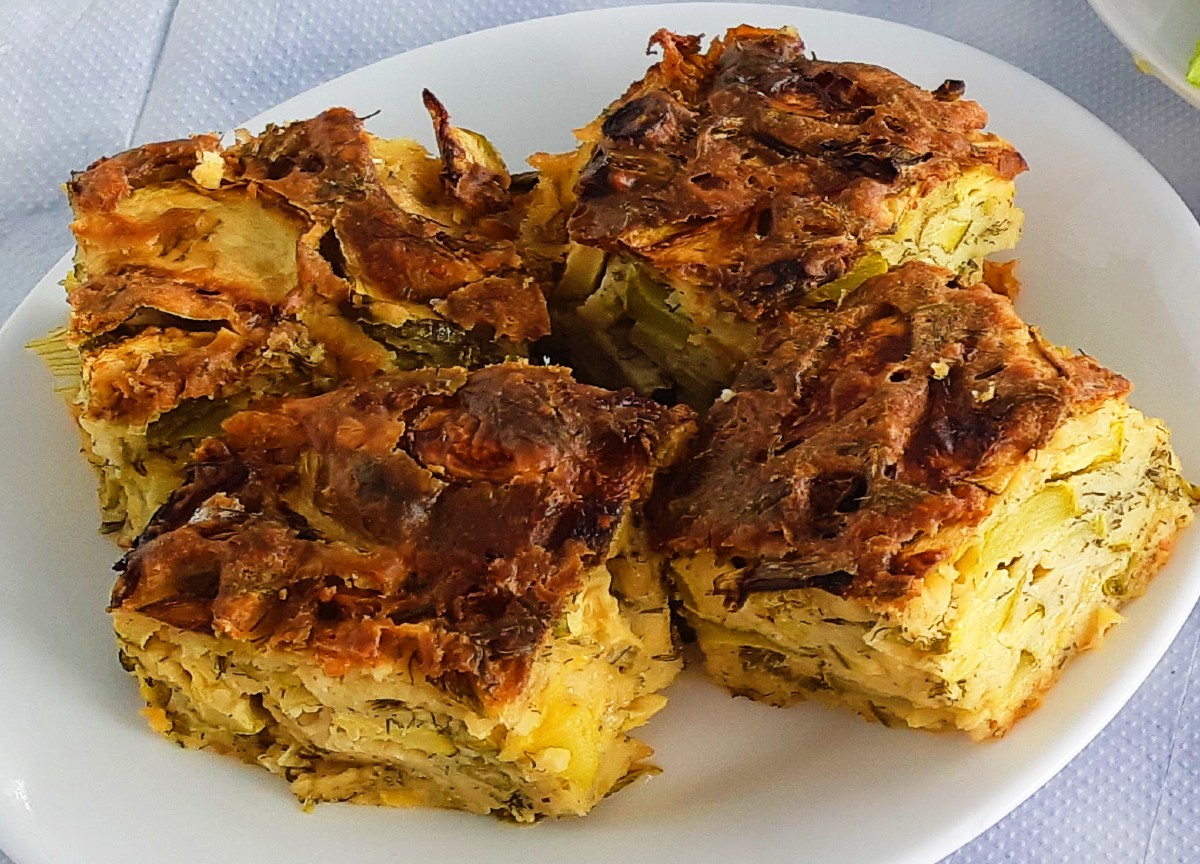
There are dozens of different versions of a tiropita – some are made with thin filo pastry, while others are made with puff pastry. Generally speaking, the filling consists of eggs and cheese, in various analogies.
You will find different local versions in each region of Greece – try them all!
Gemista
– Main (Usually vegan)
This is a delicious summer staple which you will find in most tavernas. They consist of stuffed vegetables filled with a mix or rice, onion, herbs, and often pine nuts and raisins.
Gemista are among the many Greek dishes that we call “ladera“. The word literally means “oily”, but it indicates a vegan dish. Occasionally, you might find a version with minced meat. If you are vegetarian / vegan just ask.
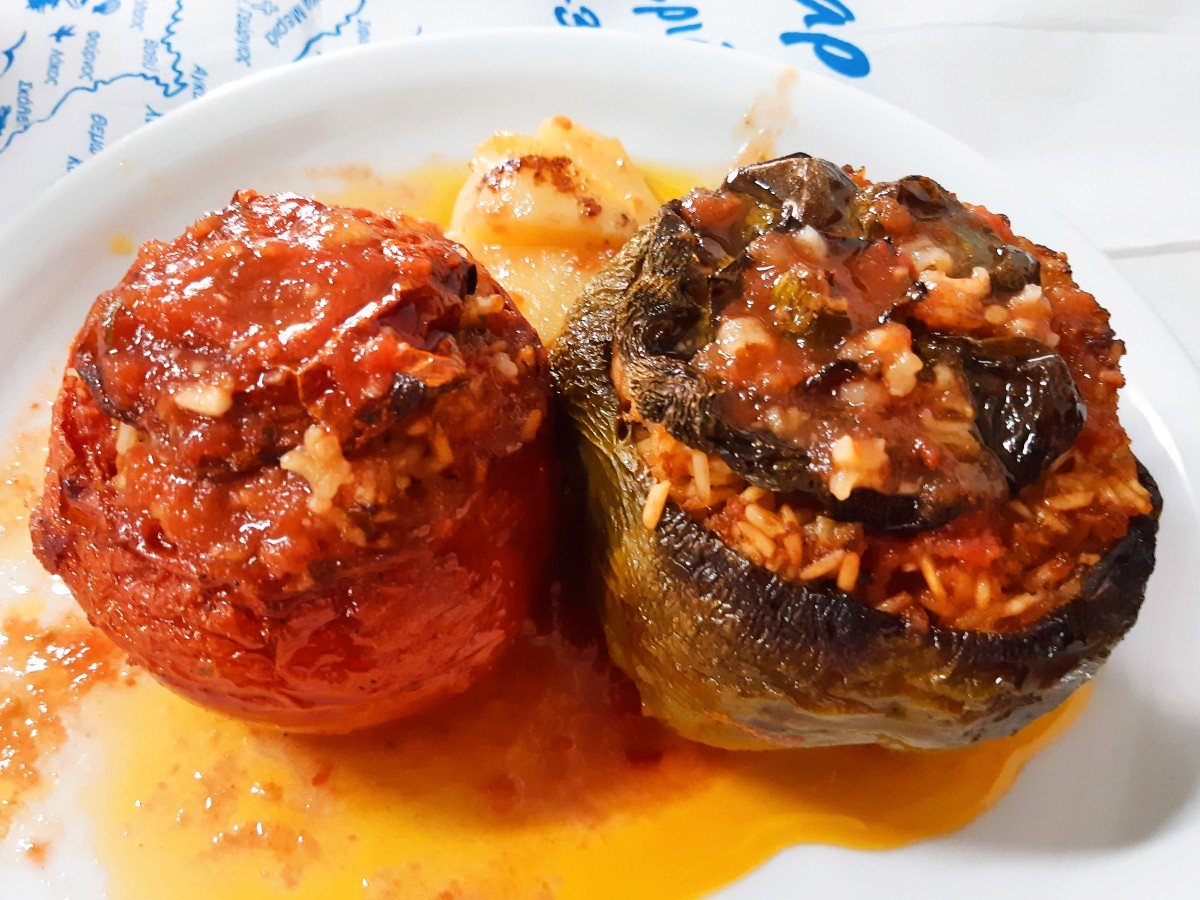
The vegetables we most commonly use in gemista are tomatoes and peppers, but you will often find courgettes and aubergines. Like many Greek vegan dishes, they go really well with feta cheese.
Until this day, I’ve never had gemista that were better than my mom’s. I will never give up trying, as they are my favourite traditional Greek food!
Htapodi – Grilled fresh octopus
– Starter
Octopus is a common appetizer, or meze as we call it in Greece. The octopus is grilled and served with lemon juice and olive oil. Occasionally, you might find boiled octopus, served with olive oil and vinegar.

I know that octopus is an acquired taste, and I’ve met visitors who won’t try it. I get it. Still, the combination of grilled octopus and ouzo or tsipouro in a seaside taverna is absolutely unbeatable.
I’d say that grilled octopus is one of the most iconic foods of Greece.
If you are a fan of octopus, look for a version cooked in the pot with pasta, tomato sauce and herbs. This is a rich dish that some people would order as a main course.
Tip – not all octopus has been fished in Greece. Sometimes, it is imported from places far away, including the Atlantic.
Sardines – Sardelles
– Main
Sardelles, or sardines, are among the most popular fish dishes in Greece. They are usually served grilled, with lemon juice, olive oil and herbs. Some restaurants serve them without the bone, but the bone is actually edible.
You can sometimes find fried sardines, which are a lot richer.

Tip – sardines are among the least expensive fish in Greece, and also among the healthiest. They are one of my favorite Greek foods. I prefer to have them with horta, or some steamed vegetables – simple is often best!
Kleftiko
– Main
Kleftiko is a unique lamb or pork dish. There are many recipes for kleftiko, often depending on the time of the year and the local ingredients.
Generally speaking, kleftiko contains onions, olive oil, wine and herbs. Other ingredients may include peppers, cheese and tomato.
There are several ways to cook it, but there is one common factor – the meat is first marinated, and then cooked slowly.
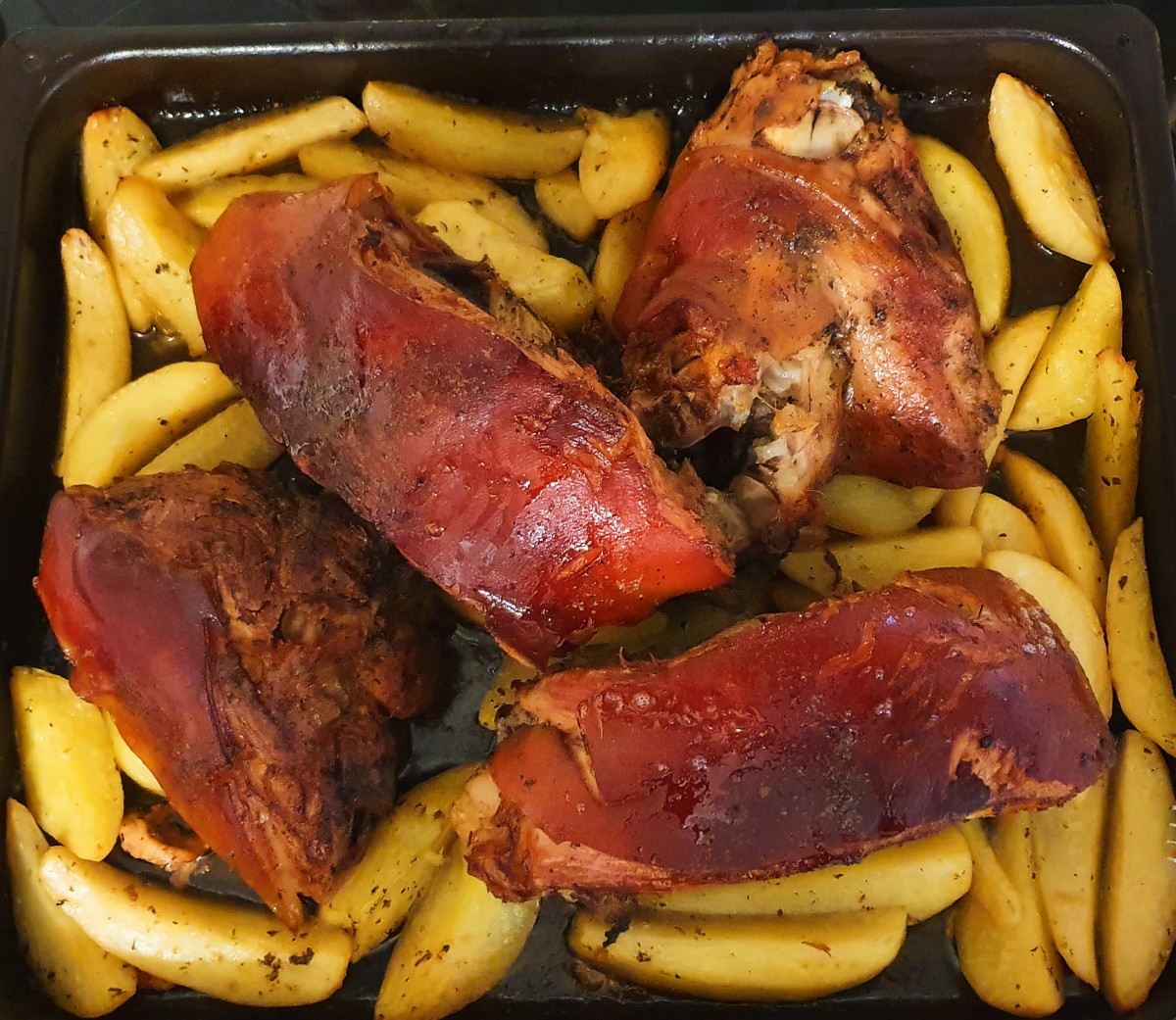
The origin of this delicious recipe goes back several hundred years, when the Ottoman Empire ruled Greece. Foods, especially meat, were hard to come by then.
Sometimes, the local peasants who were starved, managed to steal a goat or lamb. They then cooked it in a large pit on the ground, covering it to hide the smell from its righteous owners.
And this is where the word “kleftiko” comes from – it indicates something that has been stolen.
Fun fact – you may have heard of Kleftiko beach in Milos. It took its name from the pirates that used it as a hideaway.
Koulouri
– Snack (Vegan)
We could best describe koulouri as a round-shaped, semi-sweet bread covered with tons of sesame seeds. A koulouri comes in various textures, from dry and crispy to puffy and chewy.
It is the most popular quick snack in Greece, and you will see it sold at street stalls and bakeries.
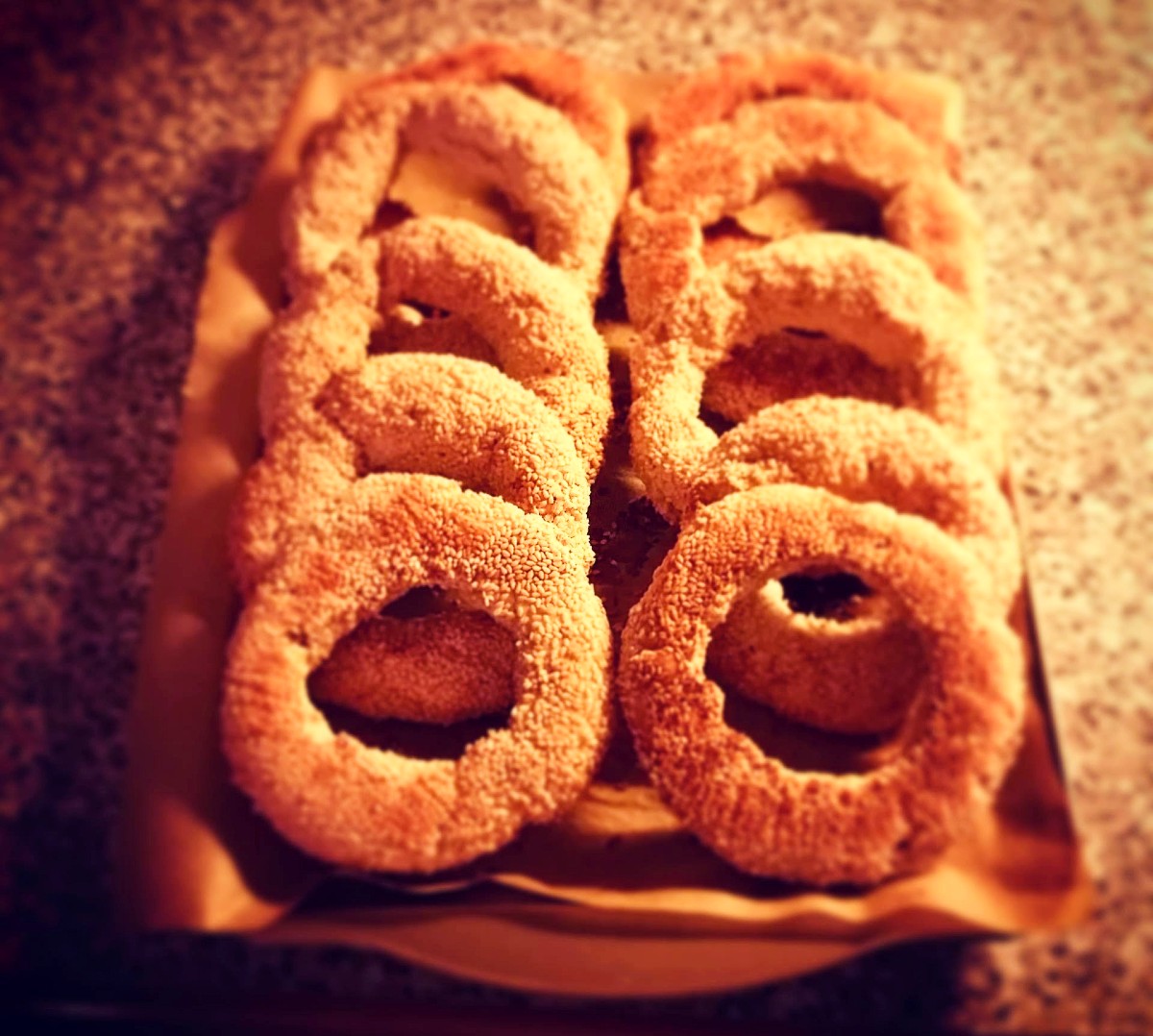
Koulouri should not be confused with “koulourakia”, classic Greek cookies. These sweet bakery goods are sold by the kilo. You can find them in many different flavours, such as orange, cinnamon or just sugar.
Elies – Olives
– Starter / Snack (Vegan)
Oh, the delicious Greek olives! There are dozens of different types of olives, of various colours and sizes. The black Kalamata olives are the most famous, but you should also try the green olives from Chalkidiki or Agrinio.
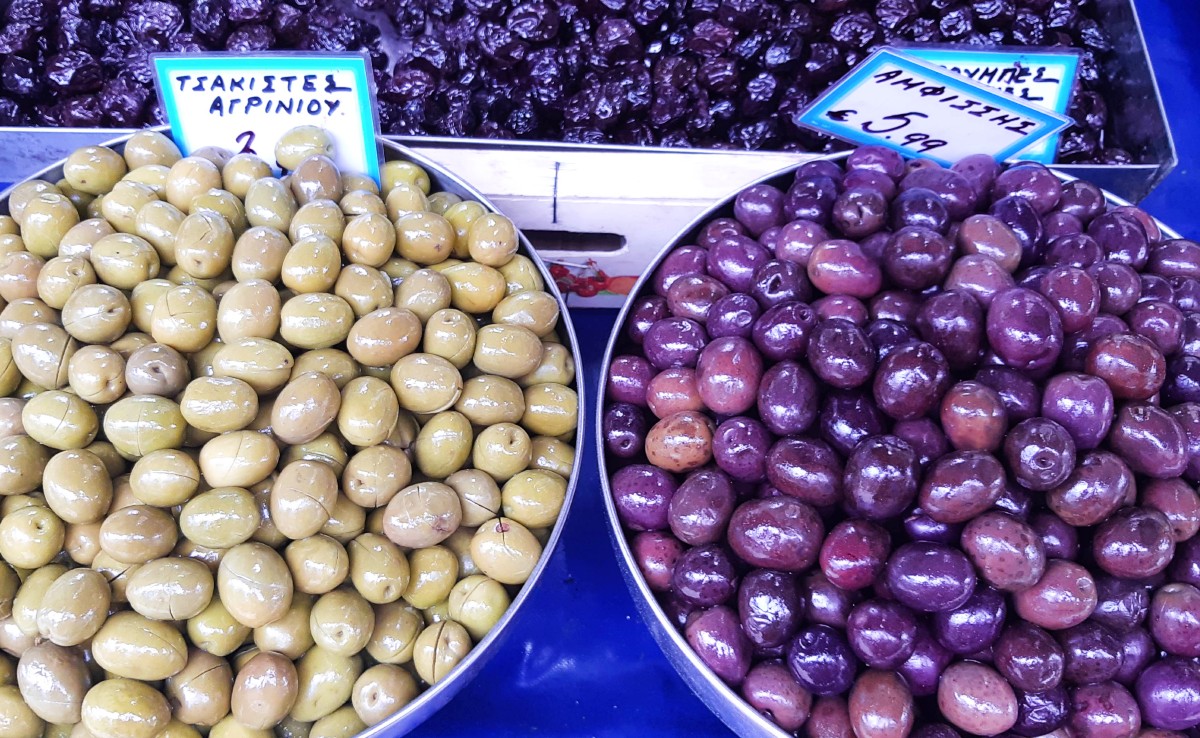
Fun fact – did you know that olives need to be cured for several weeks after they are picked from the olive tree? Curing them takes away the bitterness.
If you’ve ever tried to eat an olive straight from the tree, you know what I mean! They are normally cured in water, and lemon, vinegar, garlic or other flavourings are added in the process.
Tzatziki
– Starter / Dip (Vegetarian)
You’ll either love it or leave it! Tzatziki is a classic Greek dip which contains yoghurt, cucumber, garlic, olive oil and dill. You can eat it with bread, pita bread or your souvlaki.
In addition, it goes well with many of the other small Greek dishes, like dolmadakia or kolokithokeftedes.
Tip – Greek tzatziki is a lot more garlicky than tzatziki served in Greek restaurants abroad. Plus, the original recipe calls for fresh dill, rather than fresh mint. Just saying…
Taramasalata
– Starter / Dip
Taramasalata is a creamy Greek dip containing fish roe, bread or potato, lemon juice, possibly onion, and heaps of olive oil. It’s traditionally eaten during Lent, but you can find it in many Greek restaurants year-round.

It might not be the most photogenic Greek dish, but it’s yummy. You’ll be surprised to know that Greeks call it taramosalata, rather than taramasalata!
Melitzanosalata
– Starter / Dip (Vegetarian / Vegan)
Melitzanosalata is a creamy blend of roasted aubergine, olive oil and vinegar. It often contains garlic, tiny pieces of pepper and other spices.
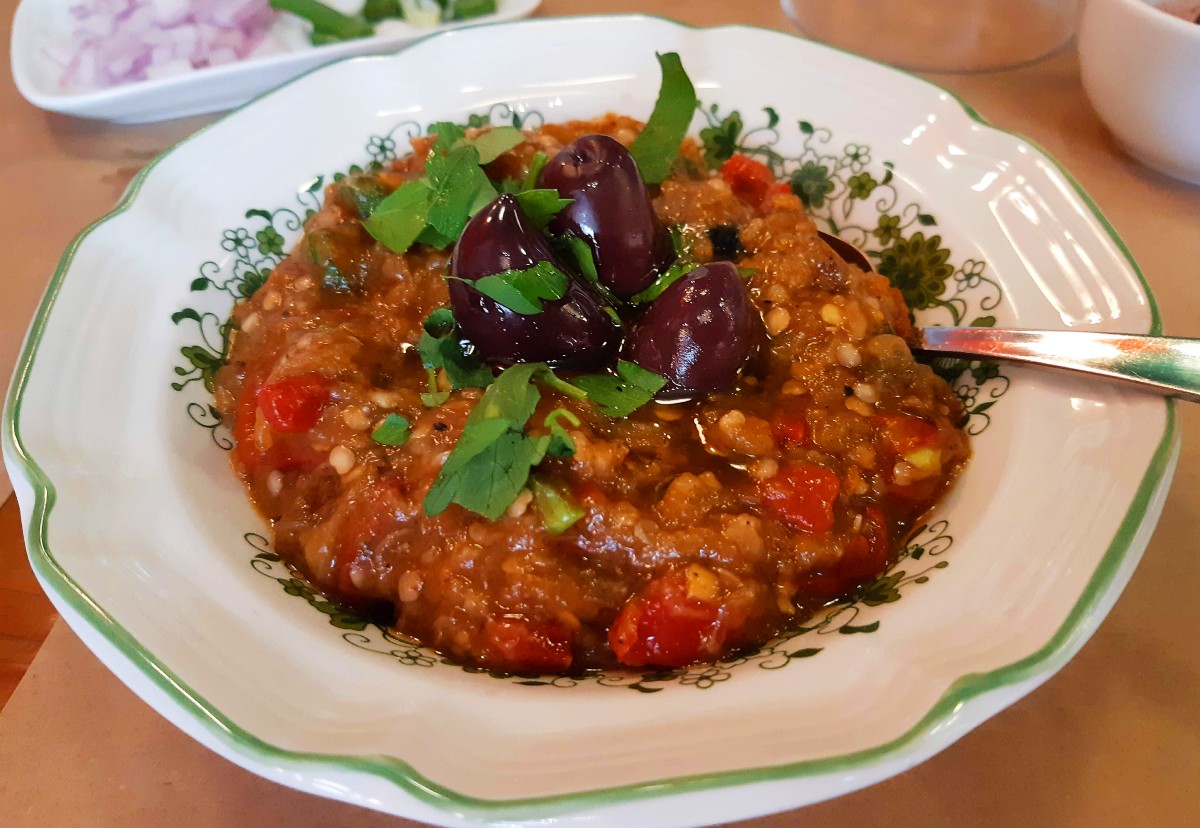
If you are vegan, ask whether yoghurt or mayonnaise has been added. It goes well with bread or pita bread.
Fava
– Starter / Dip (Vegan)
This popular traditional Greek dish features in most taverna menus. It’s a thick dip made out of Greek fava beans, which are similar to yellow split pea puree.
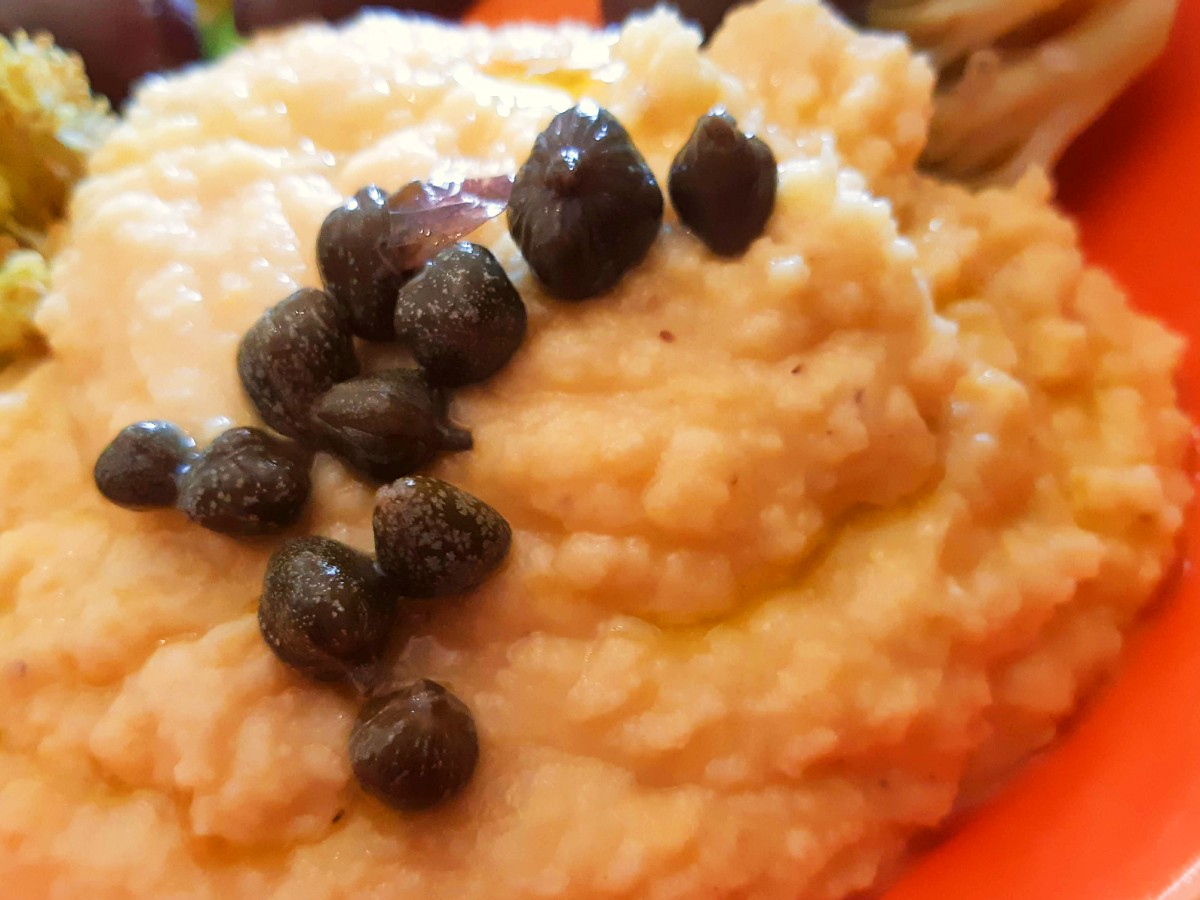
Fava can be eaten as a starter or main course. It is normally served with raw onions, capers, olives, lemon juice and good quality olive oil.
The most famous fava beans come from Santorini and Schinoussa. They actually taste different from fava produced on the mainland.
Fun fact – some people compare fava with hummus, which is a dip containing chickpeas and tahini. But did you know that hummus isn’t Greek? 😊
Dakos
– Starter (Vegetarian)
The Cretan dakos consists of a large piece of dried rusk, topped with fresh tomato, soft white mizithra cheese and olive oil. We usually add olives, capers and oregano.
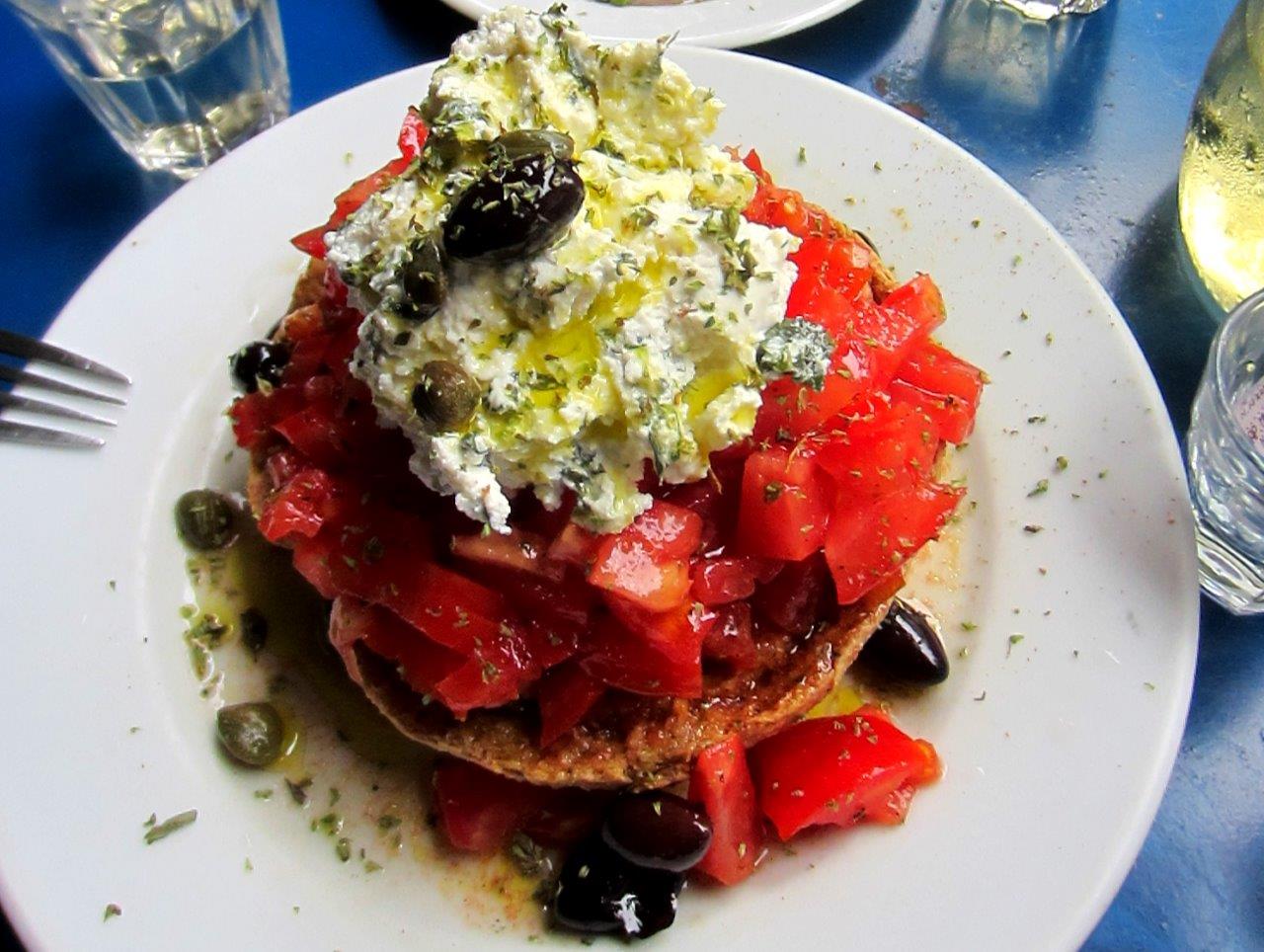
It’s a simple, but SO tasty dish. You can share it, or have it as a light meal on its own account.
Feta and other Greek cheeses
– Starter (Vegetarian)
If you are going to Greece, you will most likely have heard of feta cheese. Made out of sheep and goat milk, it has a unique texture and a strong flavour.
But feta is not the only cheese you should try in Greece. There are literally hundreds of Greek cheeses you could look for, and each little island has its own special cheeses.
In fact, the best Greek cheeses are the ones that have been made by small, local producers. Cheese lovers should definitely look out for them. Some of the Cyclades islands known for their fantastic local cheeses are Andros, Tinos, Milos, Naxos and Ios.
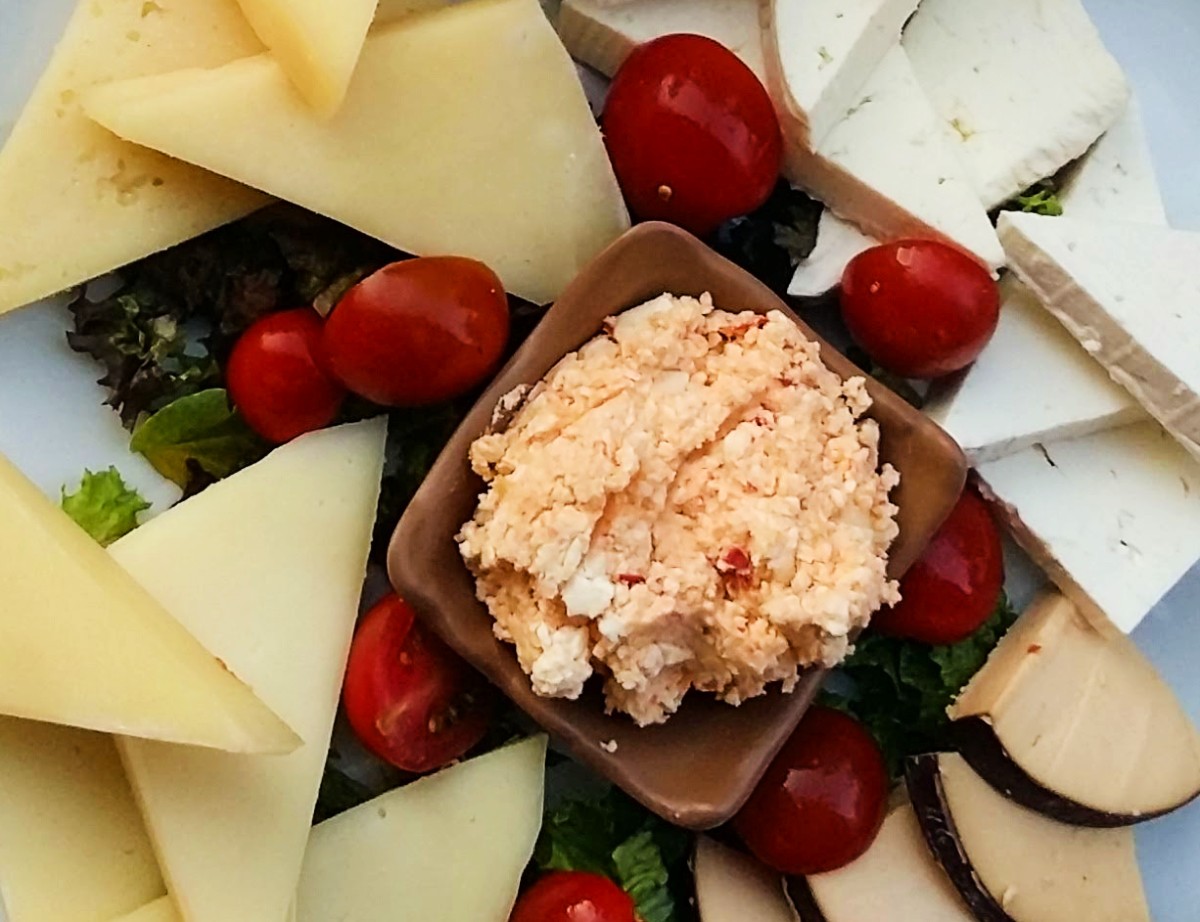
Here are some Greek cheeses apart from feta: graviera, kasseri, anthotiro, xinotyri, krasotyri, mastelo, xinotiri, formaella and manouri. Try them all! And if these words are too many to remember, just learn the one word for cheese: tiri.
Fun fact – feta cheese is a protected designation of origin (PDO) product. Greeks are very proud of it, and we totally reject any “feta” made abroad. Especially when made out of cow’s milk – eeek.
Saganaki
– Starter (Vegetarian)
Saganaki is a starter containing thick slices of fried hard cheese. It’s salty, oily and super heavy, and it has devoted fans. Some people like to sprinkle lemon juice on top.

I once thought that the word “saganaki” is Japanese, but it comes from the Turkish “sahan”. It indicates a small, shallow pan with two handles.
The cheese dish is sometimes called tiri saganaki, but most Greeks would refer to it as just saganaki. There are more dishes containing the word, like for example garides saganaki which you will find below.
Tirokroketes
– Starter (Vegetarian)
Cheese addicts will love tirokroketes, which are deep-fried cheese balls. They are somehow similar to saganaki, but they are fluffier and chewier.
Kolokithokeftedes and domatokeftedes
– Starter (Vegetarian)
Kolokithokeftedes and domatokeftedes are staple summer starters. They could be best described as deep fried courgette balls and tomato balls.
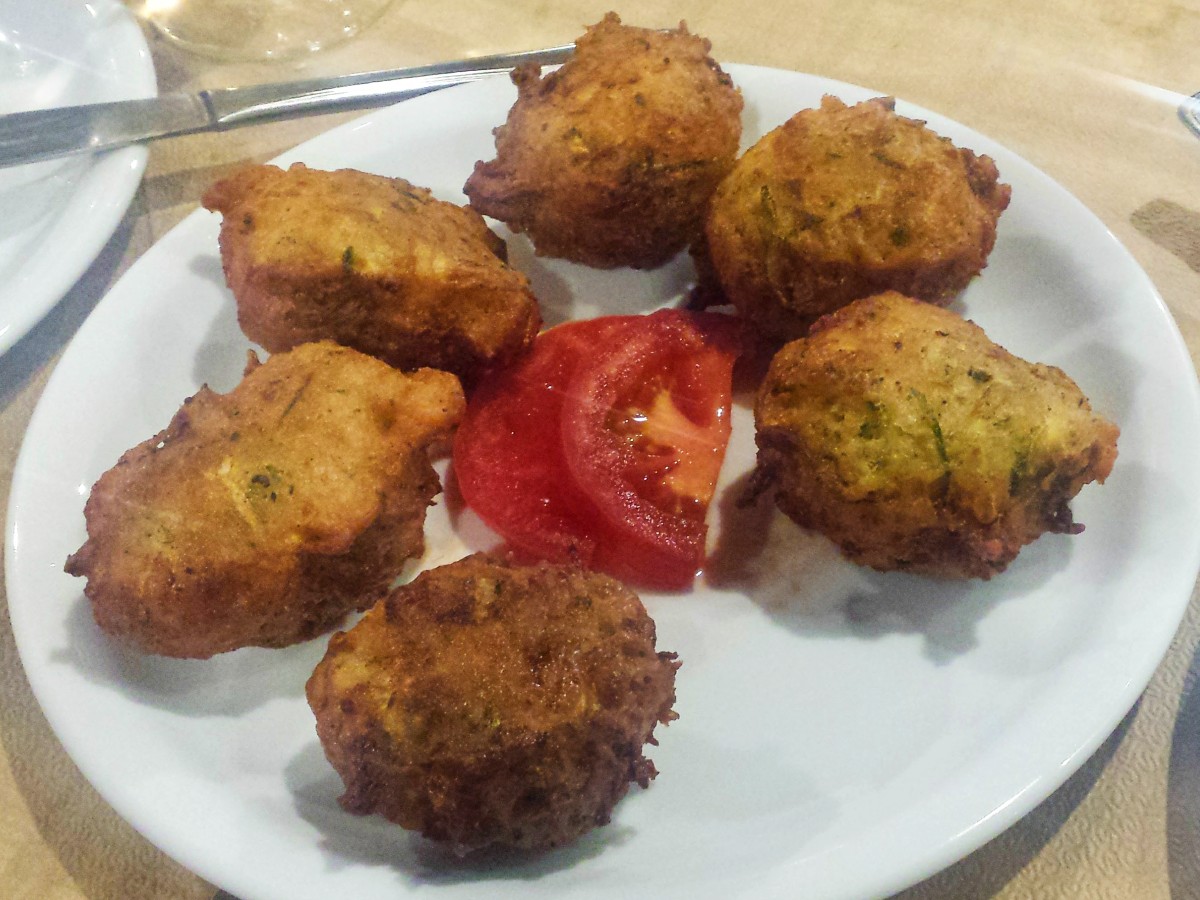
Ingredients vary – the vegetarian versions typically contain some sort of batter which includes eggs, cheese and onion. You will find them in many islands, and domatokeftedes are especially popular in Santorini.
They are best enjoyed hot, possibly with tzatziki.
Fried vegetables
– Starter (Vegetarian)
As Greece produces so many vegetables, we’ve come up with many recipes. Most restaurants will serve steamed, grilled or fried summer vegetables.
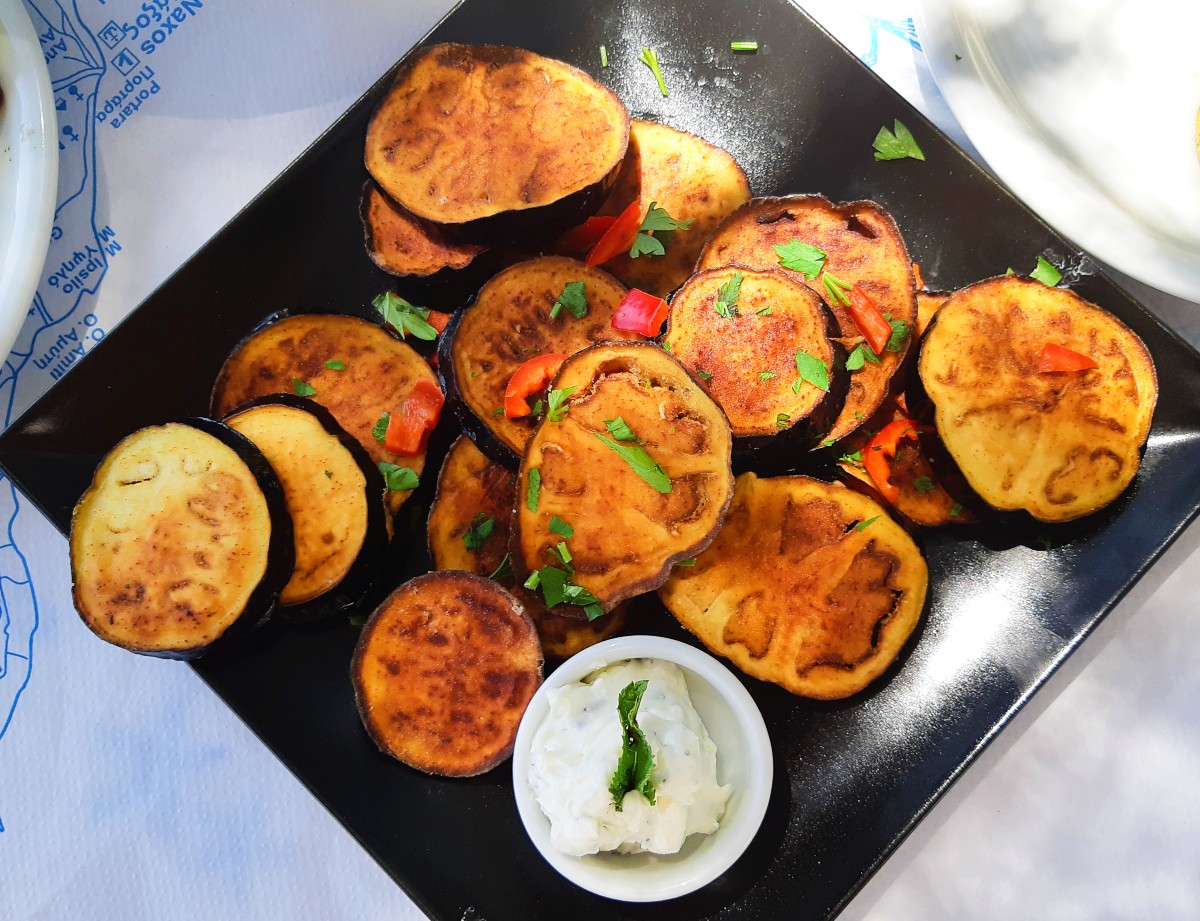
Courgettes and aubergines are easy to fry and they are a common summer starter. In addition, you will find potato chips in every single taverna in Greece. Foods just taste better with fries on the side! We call them patates tiganites.
Spanakopita – Greek spinach pie
– Starter / Snack (Vegetarian)
Spanakopita translates to spinach pie, and it’s made out of phyllo pastry, spinach, onions, eggs and cheese. Like tiropita, you can get it at bakeries, but you will also find spanakopita at many tavernas.
Sometimes, you can come across a vegan version, so just ask.

The traditional recipe for spanakopita calls for hand-made pastry. I still remember my grandmother’s pastry, fluffy and crumbly, with tons of butter and a million calories. Her Greek spanakopita would deserve all the awards in the world.
Have a look at these other Greek pastries, both savory and sweet.
Garides saganaki
– Starter
Garides saganaki are shrimps cooked in the pan with tomato sauce, feta cheese and herbs. If the combination of seafood and feta cheese sounds odd, wait till you try! Make sure you order some fresh bread to go with it.
You may recall that the word saganaki refers to the type of the pan. Or maybe not 😊
Strapatsada
– Starter (Usually vegetarian)
Strapatsada, also known as kayanas, is one of the foods of Greece that I could eat every day. It is a version of scrambled eggs with grated tomatoes, feta cheese and spices.
Often, you will find ingredients like small pieces of green pepper, capers, olives, anything really. In some areas of Greece they may add the local types of sausage.

Not many visitors are aware of this delicious Greek starter, which is a real shame! Look it up next time you visit Greece.
Horta
– Salad (Vegan)
Horta can be best described as “boiled greens”, and they are exactly that. They are served with lots of lemon juice and lots of olive oil, and they go very well with fava or grilled fish.
Here’s my complete guide on Greek horta!
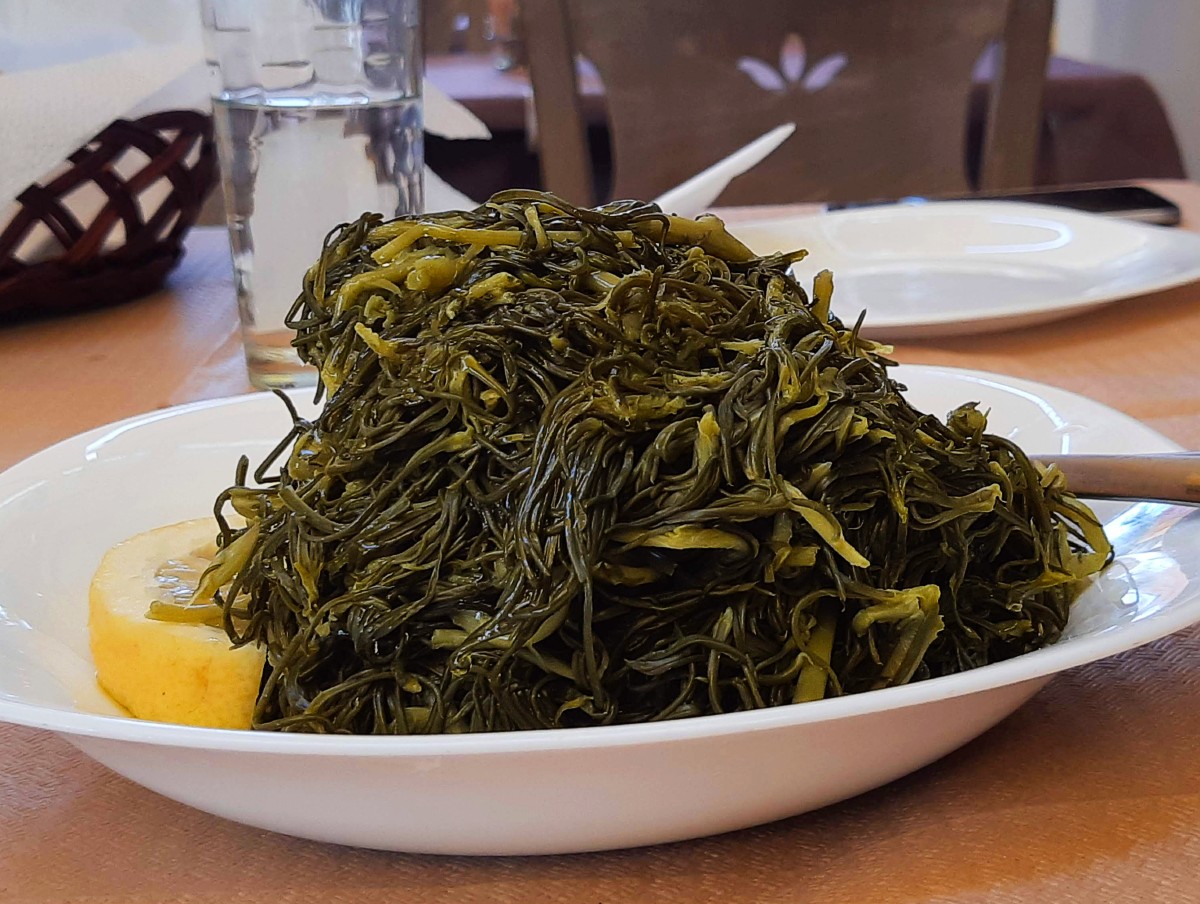
Gigantes
– Starter (Vegan)
“Gigantes” literally translates to “giants”. This popular starter consists of baked giant beans slow-cooked in a rich tomato sauce with onions, olive oil, fresh herbs and spices. They literally melt in your mouth and go very well with feta cheese.
Kalamarakia
– Starter / Main
This is a really popular summer dish. It is fried pieces of calamari (squid), sprinkled with lemon juice.

Kalamarakia are normally meant to be shared, but I have many friends who would fight over the last one 😊
Briam
– Main (Vegan)
Another summer dish, briam consists of vegetables cooked in the oven with a thick tomato sauce and various herbs. Briam usually contains courgettes, carrots, aubergines, potatoes, peppers and onions, but really we use any leftover vegetable.

It’s a fantastic vegan dish, which we normally eat with fresh bread and feta cheese.
Fasolada
– Main (Vegan)
Fasolada is the true national dish of Greece. It is a simple bean soup, cooked in tomato sauce, onion, olive oil and spices. You generally won’t find it on many restaurant menus, not least because soups are traditionally eaten in winter.
After all, who would like to eat a hot soup during Greek summer?
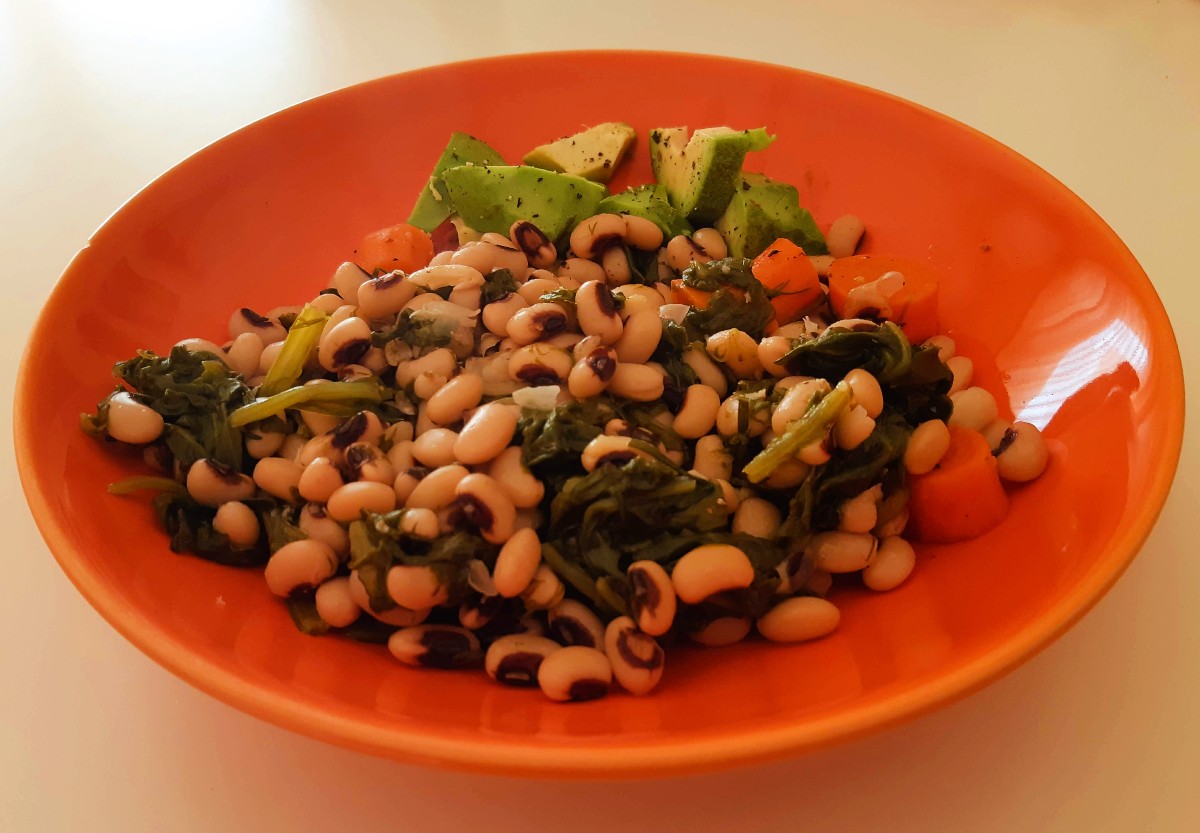
Instead, you might find a black-eyed bean salad, fasolia mavromatika. I boiled these ones along with some horta.
Okra
– Main (Vegan)
Okra, or mpamies as we call them, very rarely figure in lists about food in Greece. This simple dish consists of okra cooked in tomato sauce, maybe some wine, herbs and olive oil.

Tip – okra is most Greek children’s least favourite dish. I hated them as a kid, but love them now! We sometimes cook them along with chicken, rooster or beef.
Peas with tomato sauce or lemon juice
– Main (Vegan)
This simple dish which we call arakas contains green peas, onions, tomato sauce, olive oil, pepper and dill. It’s easy to make at any time of the year, as frozen peas are always available. Adding carrots and bell peppers makes it more interesting.
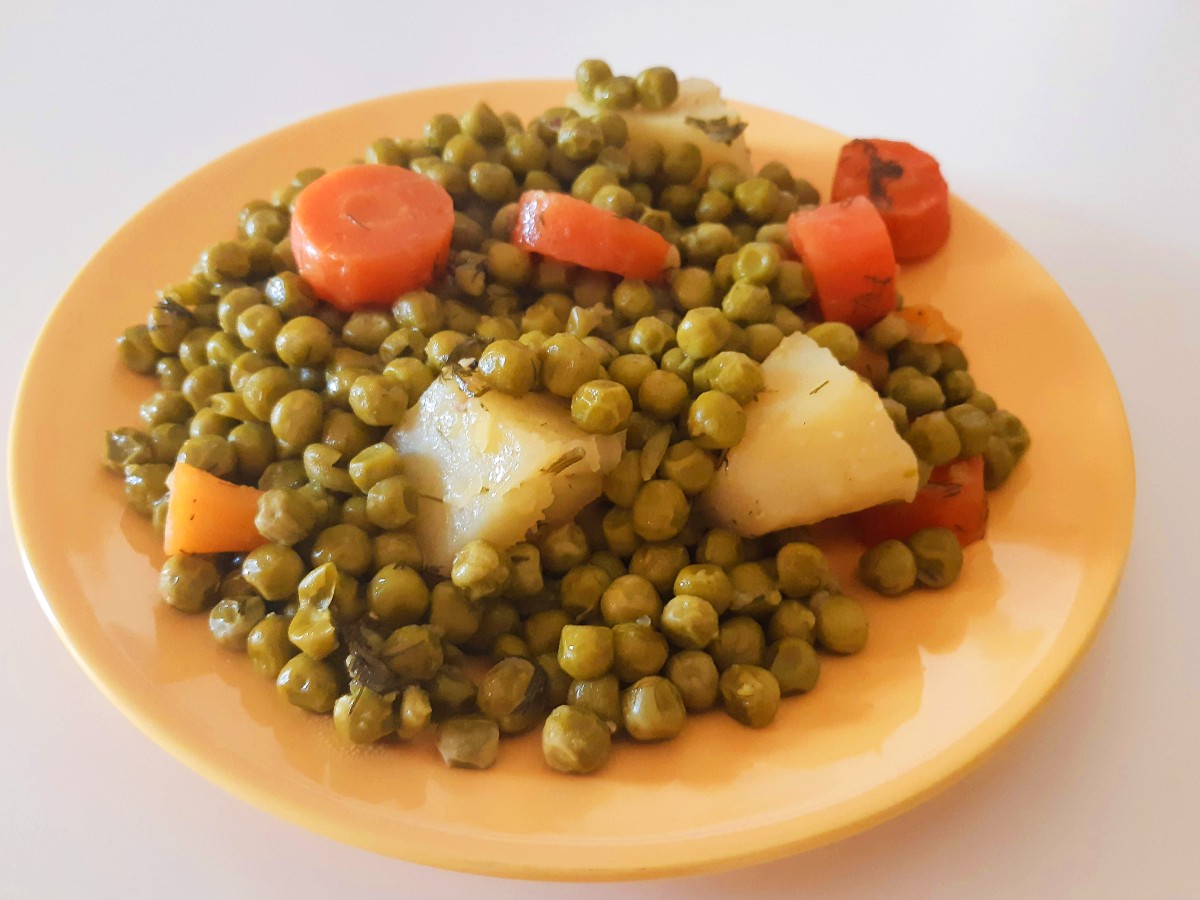
For an alternative version, you can skip the tomato sauce, and use lemon juice instead. You will rarely find peas at restaurants, but give it a go. If you are vegan, asked whether it’s been cooked along with chicken or meat.
Chickpeas in the oven
– Main (Vegetarian / Vegan)
Revythia sto fourno contains chickpeas, onion, olive oil, and many other ingredients, as regional Greek recipes may vary. They are slowly cooked in the oven, often in a claypot. Sometimes they are served with a yoghurt sauce.

You will come across this traditional dish in many parts of Greece, especially the Cyclades. All versions I’ve tried are delicious, and a fantastic choice if you are taking a break from all the meat.
Spanakorizo
– Main (Vegan)
This is a delicious vegan dish that all Greek kids love to hate. Spanakorizo contains spinach, rice, pine nuts lemon juice, olive oil and dill. I usually add carrots and lots of ginger – no it’s not Greek, but it tastes great!
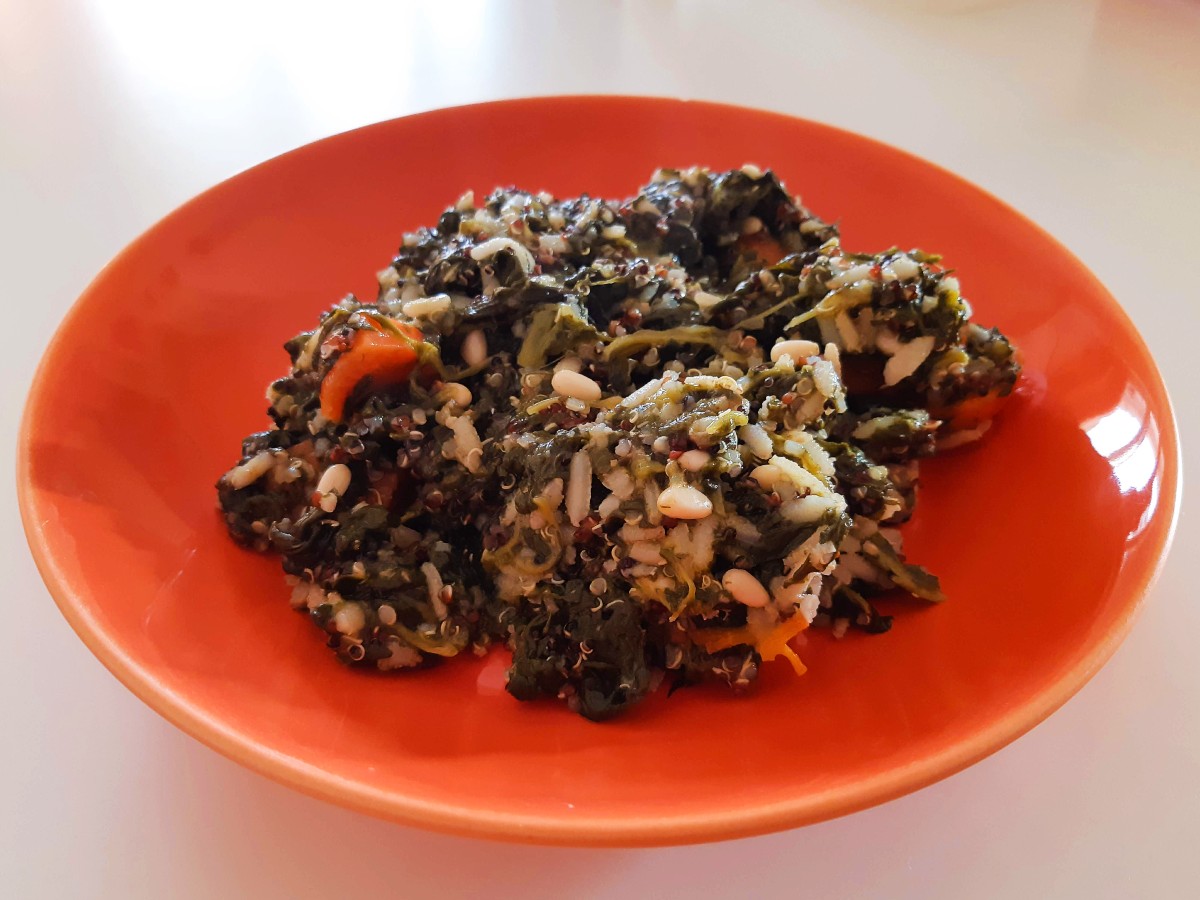
As spanakorizo is lemony, I wouldn’t eat it with feta or any other cheese. I prefer to combine cheeses only with dishes cooked in tomato sauce.
Sausage – Loukaniko
– Starter / Main
Greek sausages come in many types and sizes (pardon the pun). Generally speaking, they are made out of pork meat, but some varieties may contain ground lamb or beef. Other ingredients include spices, garlic, leek, celery, orange etc.
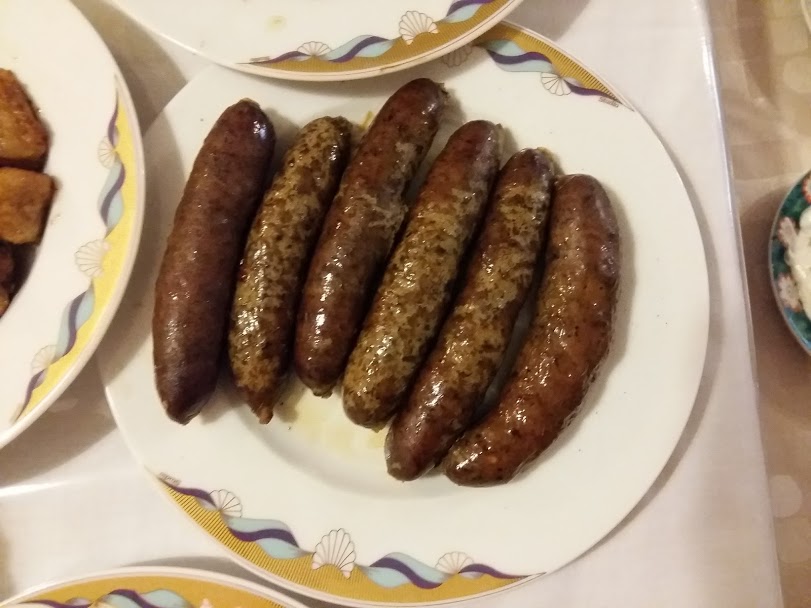
Every area in Greece has their own local version. In fact, sausages was an easy way to preserve meat when refrigerators didn’t exist. Once a pig was slaughtered, some of the meat was cooked on the spot, and the rest was preserved in various forms.
Some of the best loukanika in Greece come from the mainland. Places like Mani, Trikala, Pelion, and the whole region of Thessaly are famous for their sausages.
In addition, many of the Cyclades islands have their own special versions. Look for local sausages in Mykonos, Santorini, Tinos and Andros.
Keftedes
– Starter / Main
You may remember kolokithokeftedes and domatokeftedes, the courgette and tomato fritters. Well, keftedes is the word used for meatballs.
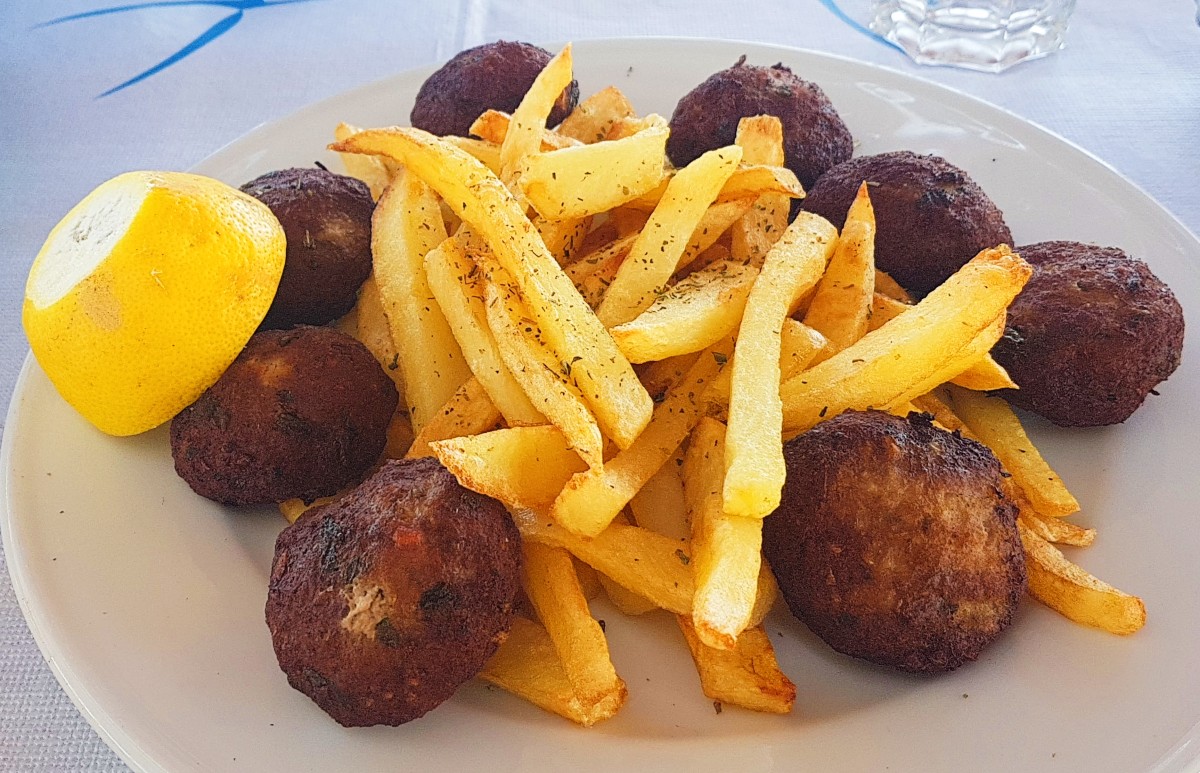
There are dozens of recipes for keftedes. Apart from ground beef or pork, most recipes include bread, onion, garlic, parsley, and cinnamon. Other ingredients often used in the mix are egg, vinegar, tomato, oregano or red pepper.
Keftedes are traditionally deep fried, and sometimes served with a thick, aromatic tomato sauce. I still remember the one my grandma made, and it’s over 20 years ago. Unbeatable.
Pastitsio
– Main
Along with moussaka, pastitsio is one of the best known traditional Greek dishes. It is a baked pasta dish, containing beef mince cooked in onions and tomato, and a tasty bechamel sauce, all baked in the oven.
It is important to use a thick, long type of pasta, with a large hole. Some people describe pastitsio as Greek lasagna.

Pastitsio is many children’s favourite dish, so if you are visiting with family give it a go. Don’t worry if your children play with the hollow pasta. Every single Greek kid did that at some point in their lives (yes, me too)!
Stifado
– Main
Stifado is one of the tastiest meat dishes of Greece. It consists of meat which has been slowly cooked with onions, tomato sauce and bay leaves.
The meat commonly used is rabbit, but you are more likely to find a beef version, as it’s more easily available.
What gives stifado its distinct, sweet flavour is the type of onion used, and the amount – the more onion, the sweeter the dish.
Melitzanes papoutsakia
– Main
This tongue twister stands for aubergines stuffed with meat mince cooked in tomato, onion and wine. They are usually coated with a final fluffy topping of béchamel sauce and cheese.
It’s kind of similar to moussaka, but it consists of whole – rather than sliced – aubergines, and there are no potatoes. You will find a recipe in every Greek cookbook.

Fun fact – the word “papoutsakia” means “little shoes” in Greek. This is what the aubergines look like when they are emptied.
Giouvetsi with pasta
– Main
This succulent meat dish is one of the most traditional foods of Greece – the equivalent of a Sunday roast. First, the meat is slowly cooked in a pot with tomato sauce, onion and wine.
The cooked meat is then transferred into a large oven dish, along with the thick sauce.
It is further cooked with kritharaki, a special type of orzo pasta that looks like long grain rice and is cooked in the sauce. Other people use chilopites, another type of pasta. Some places might also serve it with mashed potatoes, so just ask.

Giouvetsi is normally made with beef, lamb or goat. The name comes from the turkish word “güveç”, which indicates a clay pot.
Atherina, marida and gavros
– Starter / Main
These three types of small fish are deep fried and served with lemon juice. They are a popular starter, to be shared by everyone. However, some people would choose to have them as a main course, just because they are so moreish!

They go very well with a green salad or horta. Don’t forget to accompany them with our strong alcoholic drinks, ouzo or tsipouro.
Barbounia
– Starter / Main
Barbounia, or red mullets, are considered among the best fish in Greece. They are deep fried and served with lemon juice.

Unlike sardines or gavros, they are among the more expensive fish, with a distinctive taste.
Various grilled fish – Fish of the day
– Main
If you like fresh fish, you will be pleased to know that Greece has several types of large fish that can be grilled. Among the most popular ones are sea bass (lavraki), pandora (lithrini) and many types of seabream like tsipoura and fagri.
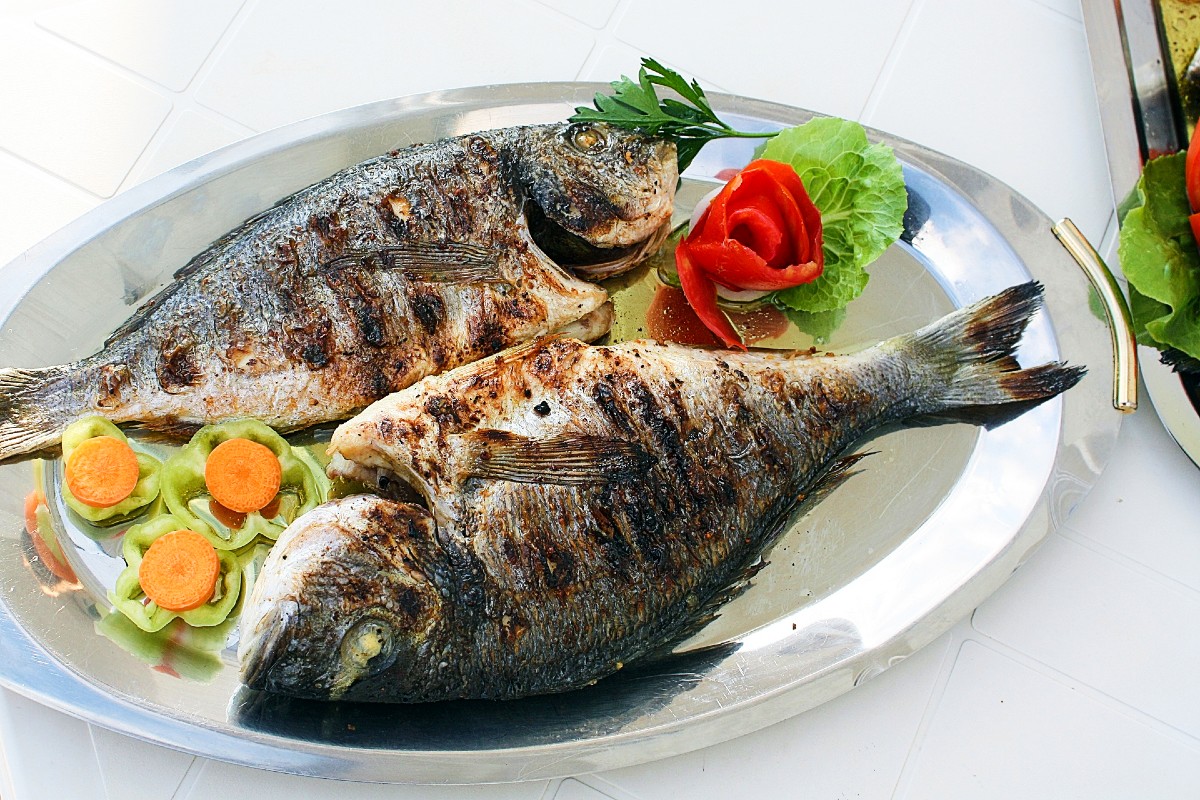
Most restaurants will allow you to check the kitchen and choose the fish you want to be cooked for you. These are normally sold by the kilo. Some types of fish are among the most expensive dishes in a Greek restaurant.
Greek yoghurt
– Anytime!
If you haven’t been to Greece, you haven’t tried real Greek yoghurt. The traditional Greek yogurt sold in Greece is very different to any “Greek yoghurt” sold abroad.

Real Greek yoghurt is a little sour, it has a thick creamy layer on top, and is quite thick in texture. You can easily find yoghurt made of cow, sheep or goat milk, or a mix.
Greek yoghurt is a very versatile food. Greeks eat it with honey and walnuts, with fruit, or just on its own. It’s a great snack for any time of the day.
Baklava
– Dessert (Vegetarian)
This super-sweet syrupy dessert contains flour, melted butter, nuts, sugar, and lots of spices. Its origins are unclear, and many countries claim that they invented it.
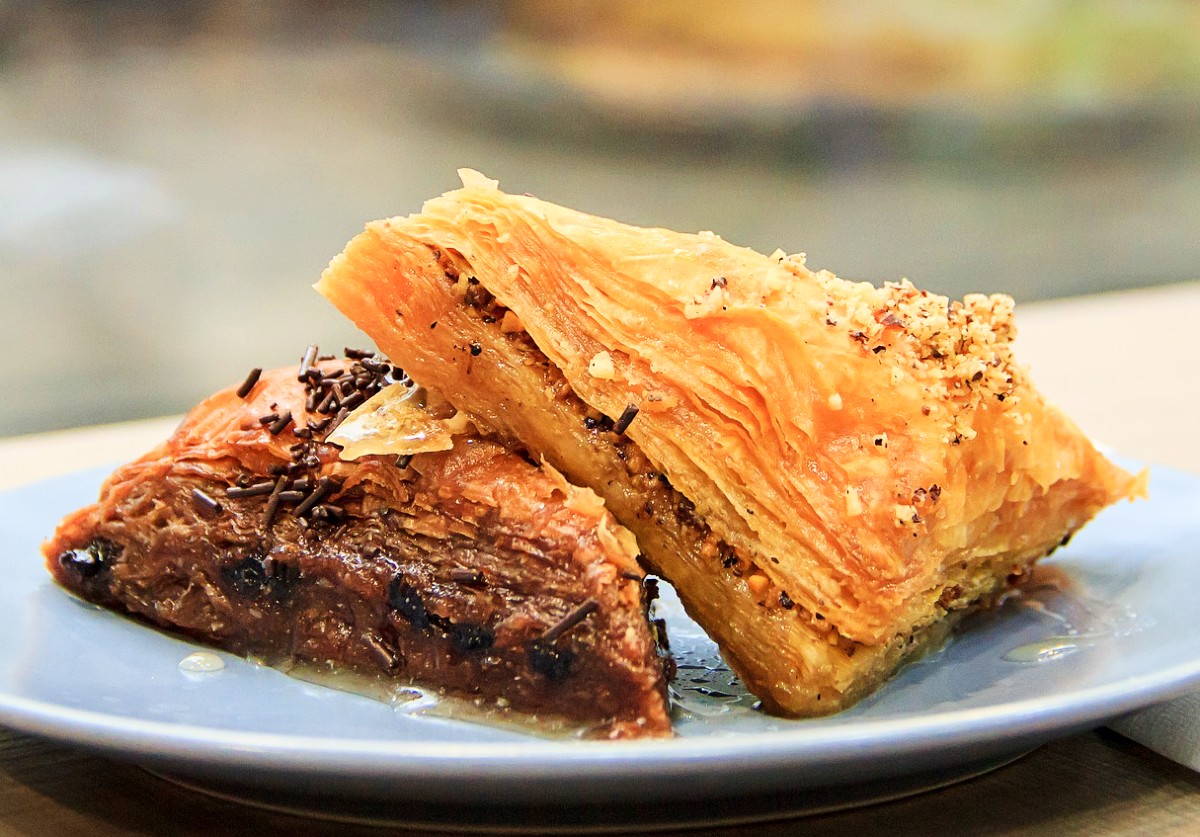
What is certain is that people with a sweet tooth can never have enough of it! It goes very well with kaimaki ice-cream.
Halva
– Dessert (Vegan)
There are more than one Greek desserts that are called halva. The one you will often find at tavernas is made out of semolina, oil, sugar and water. Occasionally, it also contains almonds.
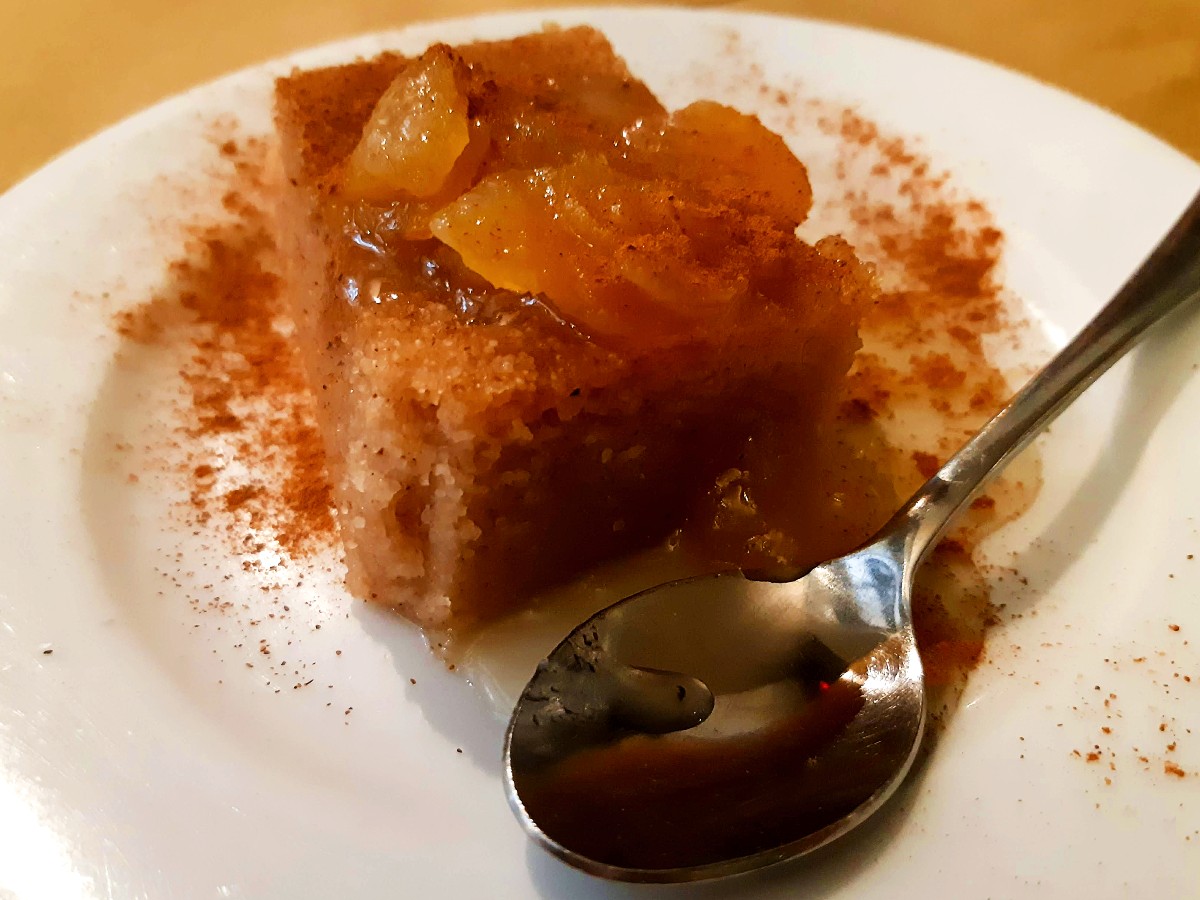
Halva is usually served with cinnamon and maybe some extra syrup, or a traditional “spoon sweet” made out of fruit and sugar. Many tavernas offer it as a treat after a long meal.
Bougatsa
– Dessert / Snack (Vegetarian)
A bougatsa looks almost like a tiropita, but it’s sweet. It’s made with pastry, and the filling contains milk, butter, eggs and sugar. It’s kind of similar to semolina custard.
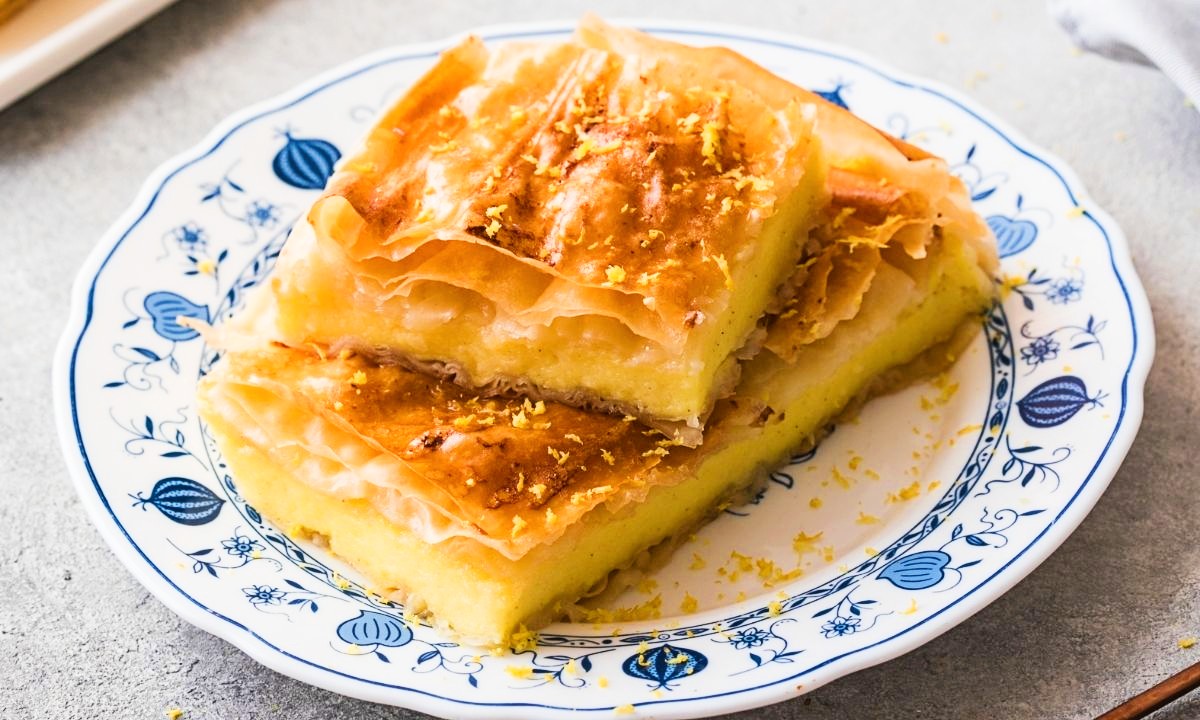
It’s a rich, creamy dessert that most children – and adults – love. Some patisseries choose to serve it with cinnamon and extra sugar on top!
Here are a few more Greek desserts for you to try.
A few more tips on foods of Greece
This list is nowhere near complete, but it should give you a good idea of the variety of Greek dishes. You should know by now why dedicated vegetarian / vegan restaurants aren’t strictly necessary in Greece.
You will have noticed that olive oil is used in almost every recipe. Personally, I couldn’t imagine my life without olive oil! I missed it a lot on some longer trips abroad.
Plus, Greek olive oil is the best, and it’s impossible to convince any Greek otherwise. Never, I mean NEVER, tell a Greek that Italian / Spanish / You-name-it olive oil is better. You will make an enemy for life.
Here’s a cool myth that explains the importance of olive oil since the times of Ancient Greece: How did Athens get its name?
On the other hand, not all our meat dishes contain lamb or goat. In fact, we mostly cook those on special occasions, like Greek Easter for example. But you will generally find one or two dishes with goat or lamb in many tavernas. I, for one, don’t eat either of them – yes, there are these Greeks as well 😊
Last tip – food normally comes with bread, rather than pita bread. That’s right – traditional, fluffy bread that we tend to dip in the olive oil and rich sauces. We normally eat pita bread just with souvlaki or gyros.
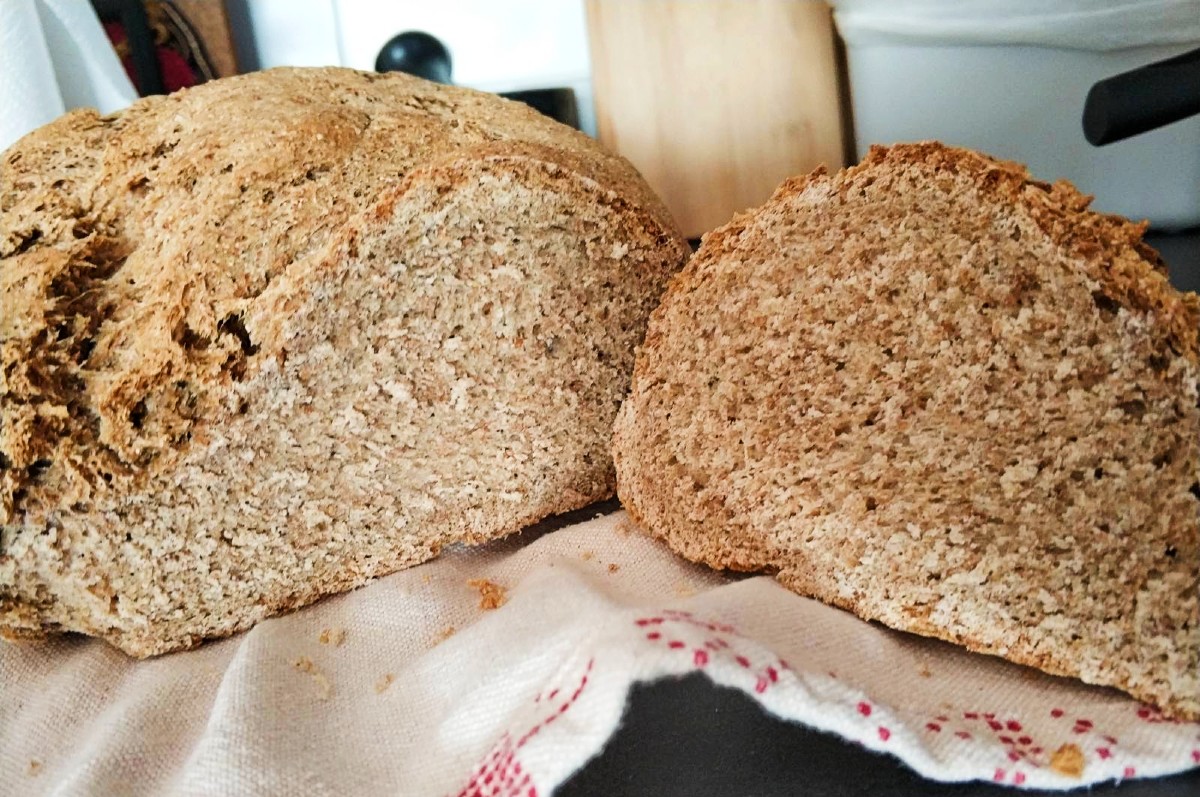
Now, I cannot stress it enough. Food from Greece is important, but what matters more is the company. Sharing food, wine and thoughts is one of the things that Greeks know how to do best.
My advice – when in Greece, do like the Greeks. Take your time to enjoy our food, and relax over a glass of wine or tsipouro.
More Greek food guides
Speaking of wine, if you are wondering what to drink with your meal, here are all the Greek drinks you need to try.
This guide will help you when ordering food in Greece.
This one will explain everything you need to know about Greek tavernas.
Here’s my guide on tipping in Greece – and a few useful Greek words and phrases.
Not feeling hungry? Go out for a Greek coffee instead! Or swing by the quirky Little Kook cafe to see the decorations and have a cup of chocolate.
If this is too much information, you can always take a Greek food tour, and have an experience that will make you love Greek food!

Hi! I am Vanessa from Athens, and I love helping people discover more about Greece. I grew up among two grandmothers who were both known for their cooking skills. My mom took up some of their best recipes and made them even better! While I love international cuisine (especially Asian dishes), I really think that the food of Greece rates very, very highly. Hope this guide on what to eat in Greece has given you some ideas for your next visit!

thanks alot of information goodjobs
Thank you so much.
We fly to Greece in 2 weeks and do have a food tour booked for our first evening.
I am looking forward to trying many of the dishes you wrote about!!
Again,
Thanks :)))). Sue
Hi Vanessa! I had a delicious cheese dish last night in Thessaloniki but I didn’t quite catch the name — I think it started with a B. It was baked in a clay dish, the server said it was a mix of different kinds of cheese with feta on top, and included a lot of herbs and different kinds of green and red diced peppers – it was actually quite spicy! Any idea what this was? Thanks!
This is called Bouyiourdi! There’s also a version with a spicy sausage meat, which is called pastourmas!
Yes! That’s what she said! It was delicious!! Thanks – now I know how to order it again! (Or to recognize it if I see it on a menu!)